Review of The Synology DSM 7 Software and Services
It’s been more than 3 years in development but finally, users are getting the chance to experience the full and official version of Diskstation Manager 7 (DSM 7) on their Synology NAS drives. Many users chose to invest their money and their data in a Synology NAS because the brand has an incredible reputation in the industry for their software and services, included with the hardware purchase – with DSM being one of the biggest draws. What once started as a slightly rudimentary network file manager tool, has now evolved dramatically over 20 years into its own fully-fledged equivalent operating system with applications, multi-user management and a wide range of inclusive software and services. The latest full version, DSM 7, was first previewed way back in 2018 at Synology’s annual launch event and has been in constant development all this time. With numerous massive changes between DSM 7 and DSM 6.2, ranging from the way applications are handled and backend tweaks to performance and security throughout, DSM7 is the equivalent of upgrading from Windows 7 to Windows 10 for many users, and I am pleased to say that it accomplishes ALMOST everything it promises. Today I’m going to give a full and detailed review of Synology’s DSM 7.0 system software update, the highs, the lows and ultimately whether now is the time to upgrade your Synology NAS to this new and impressive version.
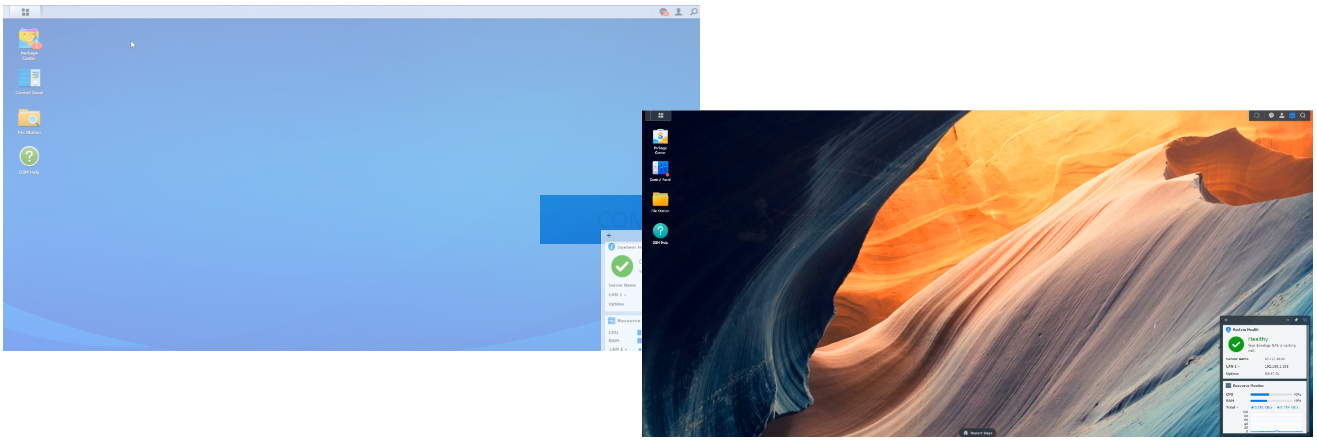
Synology DSM 7 Review – The Quick Conclusion
Let’s not mince words, the Synology DSM 7 software is easily the best experience you are ever going to have when accessing your decades of data! From huge upgrades in the graphical user interface, the layout of options and even managing to improve the already exceptionally user-friendly design, DSM 7 is unquestionably the king of network software right now. Aside from a few areas of design conflict between DSM 6.2 services and DSM 7 UI, questionable changes on USB compatibility and contention over migration between in photo station and Synology photos, DSM 7.0 still very much rules the roost when it comes to the best you can get in network-attached storage software in 2021/2022.
| PROs of DSM 7.0 | CONs of DSM 7.0 |
| Genuinely Impressive Latency
Very Appealing GUI Unbeatable First Party App Support Near Perfect Single EcoSystem Makes DSM 6.2 Look Dated Fast RAID Repair and RAID6 Improvements Surveillance, VMs, Backups and Media Handling all still 10/10 Feels JUST as Secure & Safe as Ever Hyper Backup & Cloud Sync Still Support MANY Clouds Active Insight, Active Backup, C2 & HybridShare = Business Win |
Reduced USB Support Currently
Some 3rd Party Applications have not migrated well Synology Photos Still Lacks some Photo Station Services Hybrid Share ONLY Supports Synology C2 (Paid Sub) Occasional Conflict of DSM 6.2 to DSM 7 Designs at times Synology Drive File Pining & Active Backup Still not Available for Mac |
Synology DSM 7 Review – The New User Interface
DSM 7 makes a very early positive impact on the user after the update has been installed, with the new login screen and improved login options. The previous DSM 6.2 login screen was clear and functional, but might have been a bit tame (though customization was possible to a small degree). Synology has scaled up the new login screen on this new diskstation manager software to remember a much more modern and slick UI, with the username and password entry being separated across slides – rather than together. Whether this is a layered security measure or this was necessitated by those using OTP login (2 step authentication etc) or Synology’s own secure signin application, it’s still a very, VERY clear UI straight off the bat!
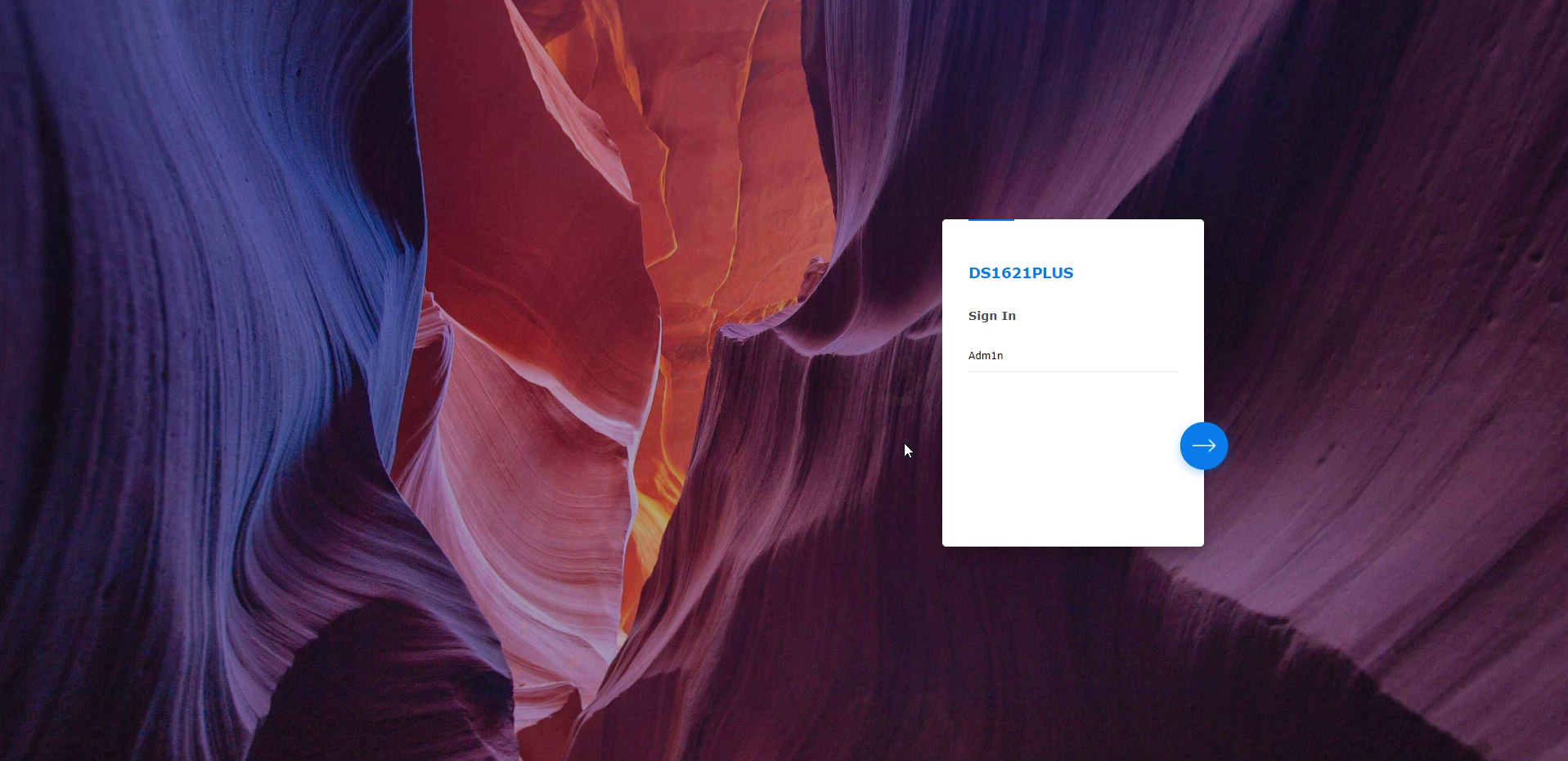
As mentioned, Synology has released together with DSM 7, the secure sign-in application for Android/iOS to allow ‘in-house provided’ 2 step authentication into the NAS. Although this is a nice extra and I can see a lot of larger businesses who use the Synology NAS platform for their teams/staff using this, I think most other users will continue to use their existing authentication tools (e.g Google Authenticator) for simplicity across their own software environments. However, these are still very much supported in DSM 7 (as they are in DSM 6.2) with increased OTP support on this update.
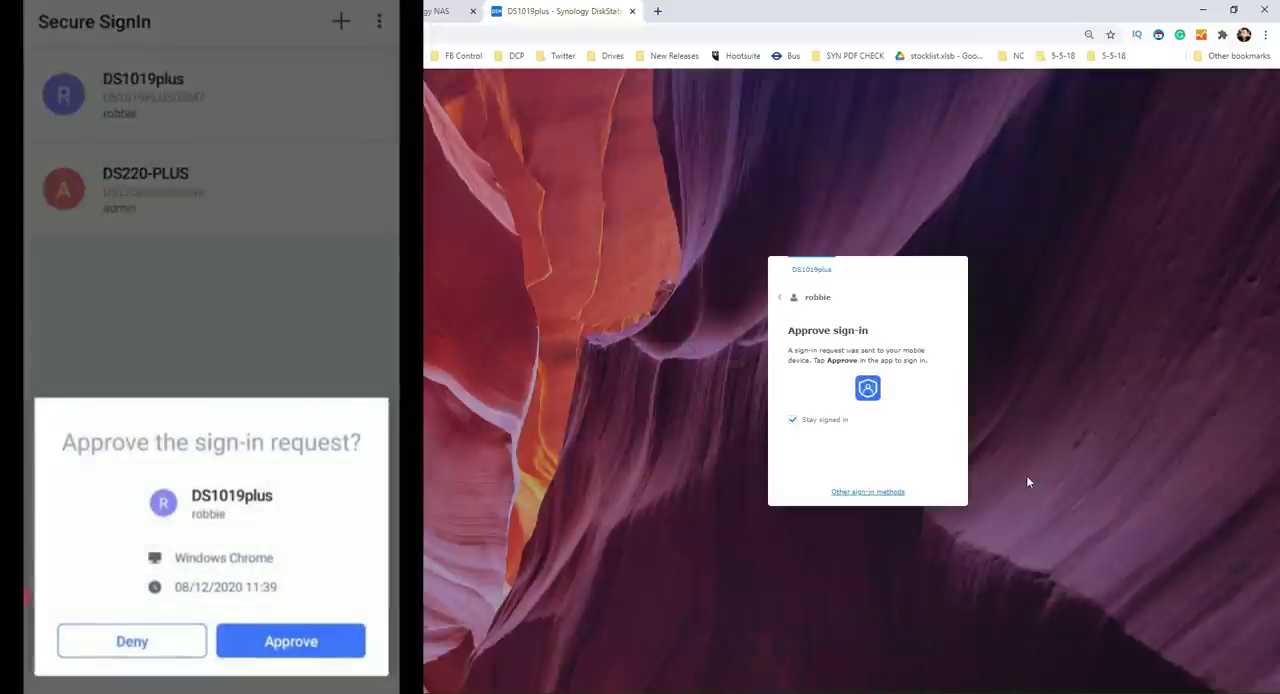
The login speed of DSM 7 is still something I think deserves ALOT of attention. The localized feel of DSM 7 is something that is impossible to ignore. It is easy to forget that when you are interacting with the Synology NAS via your web browser (Chrome, Mozilla, Safari, etc) that you are only accessing a portal/tunnel to the NAS via the network/internet – which given the responsiveness of the GUI, moving windows, changing tabs, crisp quality of the layout and low latency is easily where a lot of work in DSM 7 development went. Not just reducing any delays, but doing so whilst still maintaining the same/higher level of secure and encrypted transmission. A quick look at the range of supported applications on DSM 7 shows that pretty much all of the applications that people use on a Synology NAS are available here (with a few applications being renamed e.g iSCSI Manager>SAN Manager, whereas others have been merged together, e.g Synology Photos).
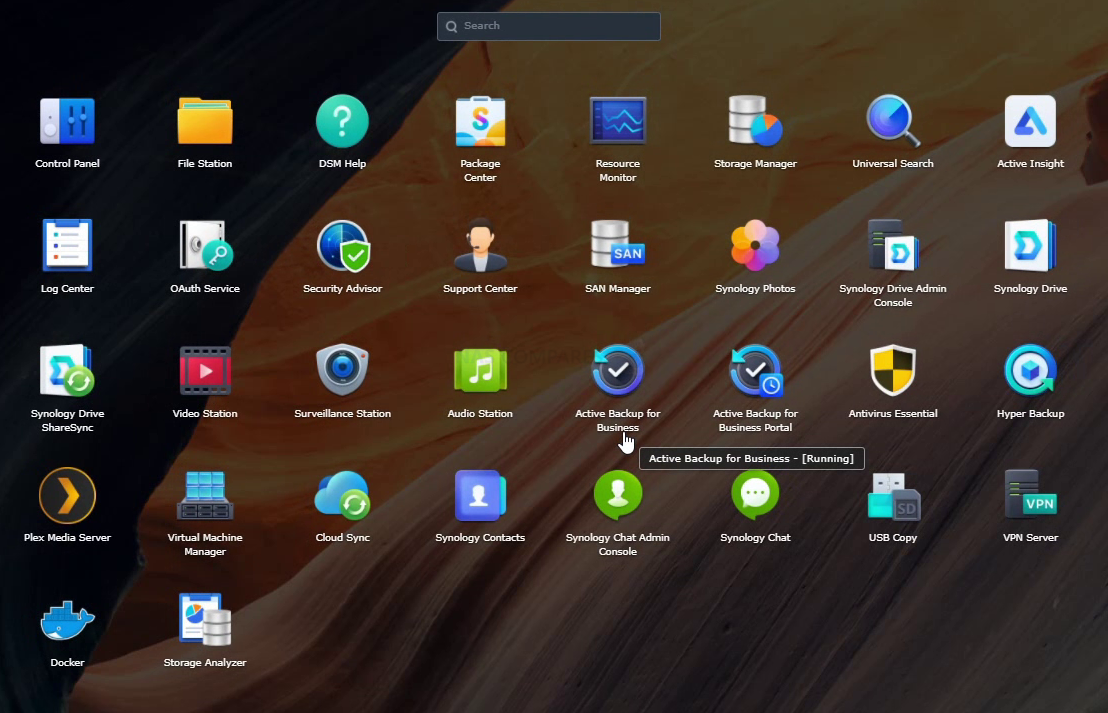
The applications listed in the Synology Application center are all where you would expect them to be for the most part, though HybridShare still remains in the Beta category (which is actually quite advantageous when I was reviewing the final version as the Synology C2 Cloud Beta capacity was still available for testing). Much like DSM 6.2, in DSM 7 you can install numerous applications at the same time and still use the rest of the system, with a few minor exceptions where key background services needed to be installed/downloaded and this prevents simultaneous app installation for a period.
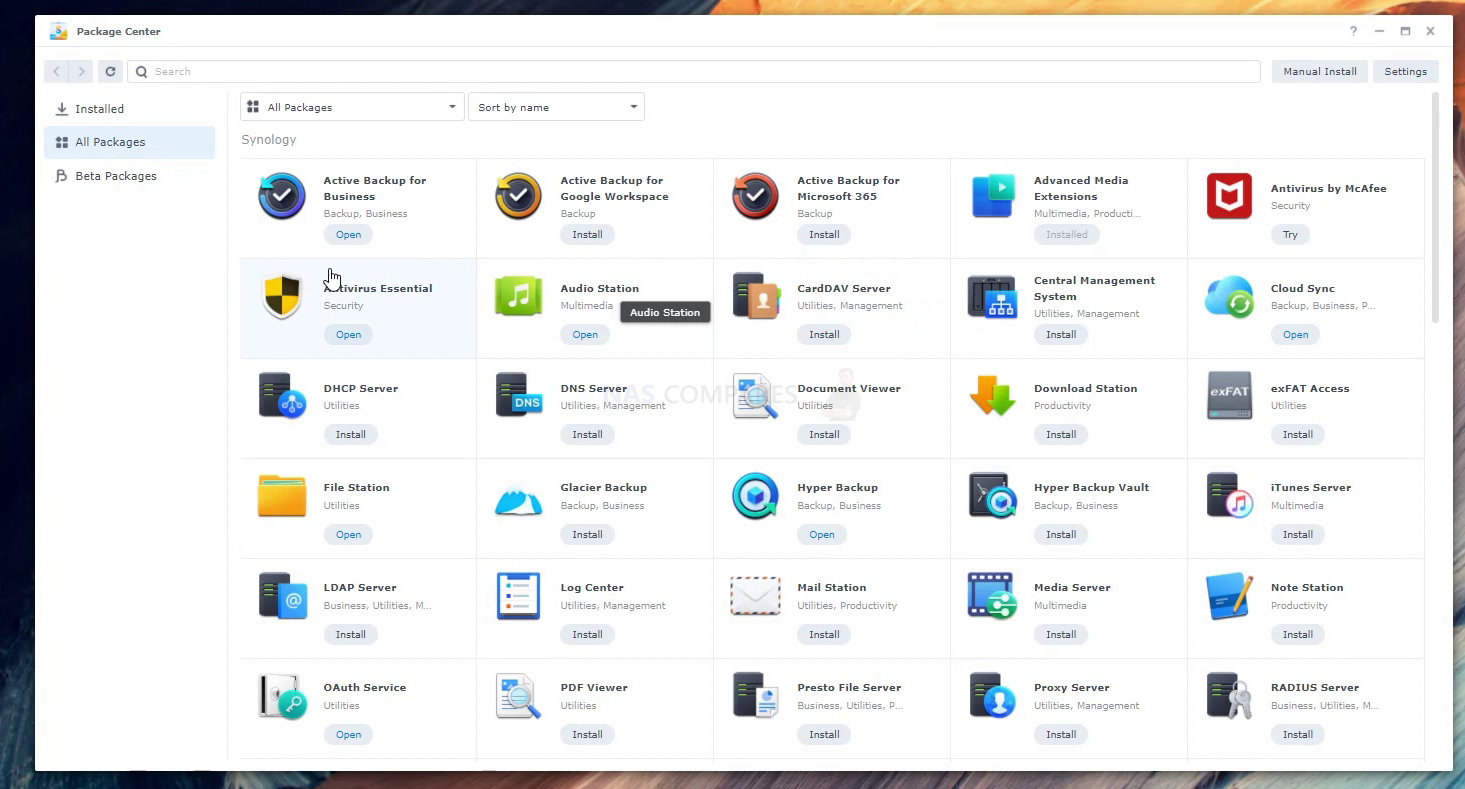
The only gripe I could find with regard to DSM 7 and application installation was first that Plex Media Server (currently version 1.22) was still in the Beta applications list and installation was not quite as clear cut as other applications (understandable for a 3rd party app) and some users have raised complaints that their existing Plex Media Server setup in DSM 6.2 was in need of fix/repair during migrations to DSM 7.0 (I did not experience this personally, but I have used DSM 7 in beta for a while and larger changes may have occurred in other versions of this software. Additionally, the range of 3rd Party applications that are supported has been noticeably trimmed down. This might well be because DSM 7 is such a modified/changed platform over DSM 6.2, that these applications are in need of re-tooling by their respective brands, but still – some of the lesser-known apps were still used in the absence of docker/container alternatives.
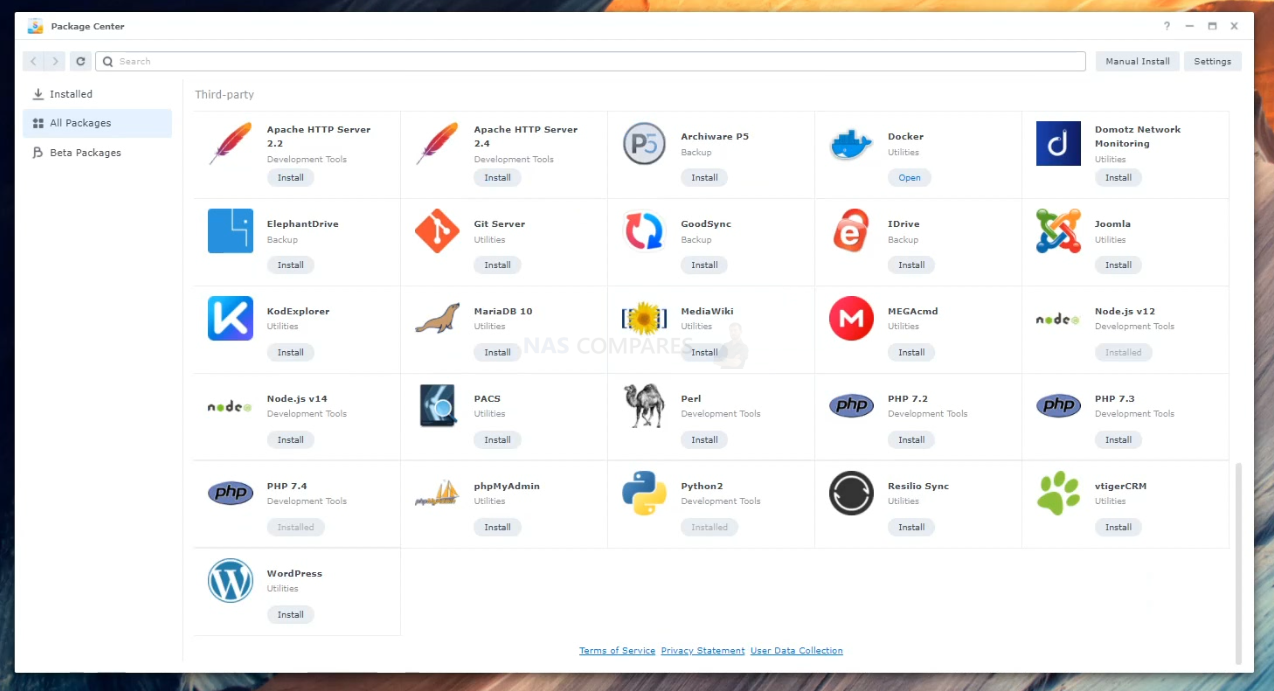
The control panel of DSM 7.0 is very similar to DSM 6.2, with a few small changes in where options are located (both in the primary menu and sub-menus), and once again the simplicity, ease and user-friendly design of the Synology Diskstation Manager Settings menus are top-notch – however, I can still see more seasoned storage professional having gripes with more customizable and configurable options being heavily buried or unavailable outside of SSH. Nevertheless, it is a VERY clear layout and intuative.
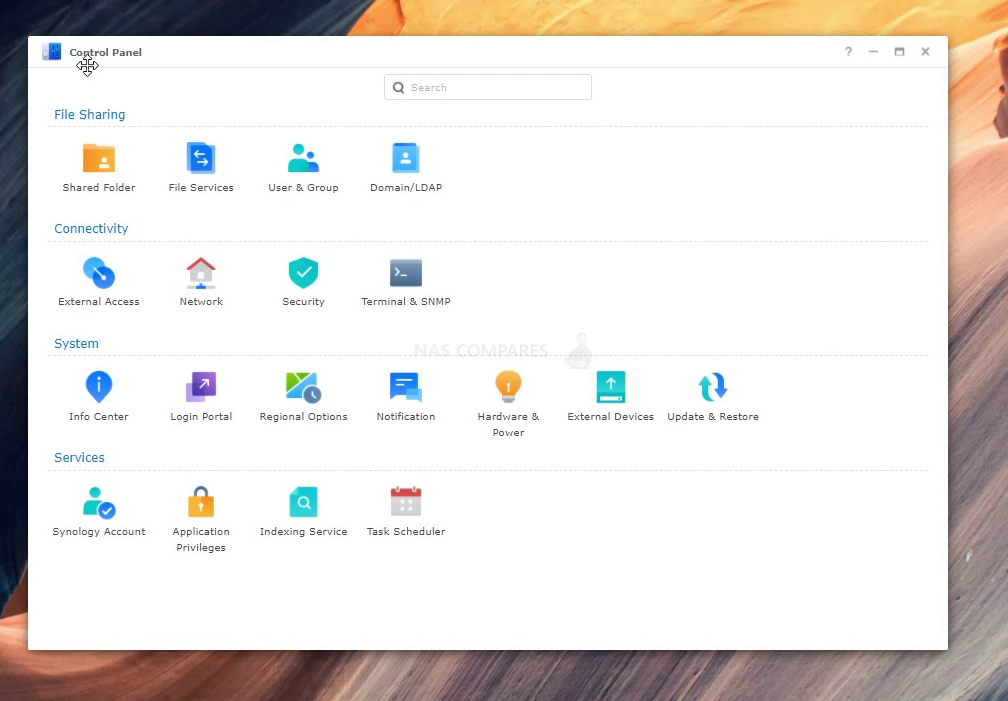
The resource monitor in DSM 7 has also received an update and is now a fraction more information than its predecessor, with more historical data options and ways to par down the stats to get more information. It’s a smaller upgrade over DSM 6.2 resource monitor, but always a change for the good to have more system health and consumption of the hardware info at hand.
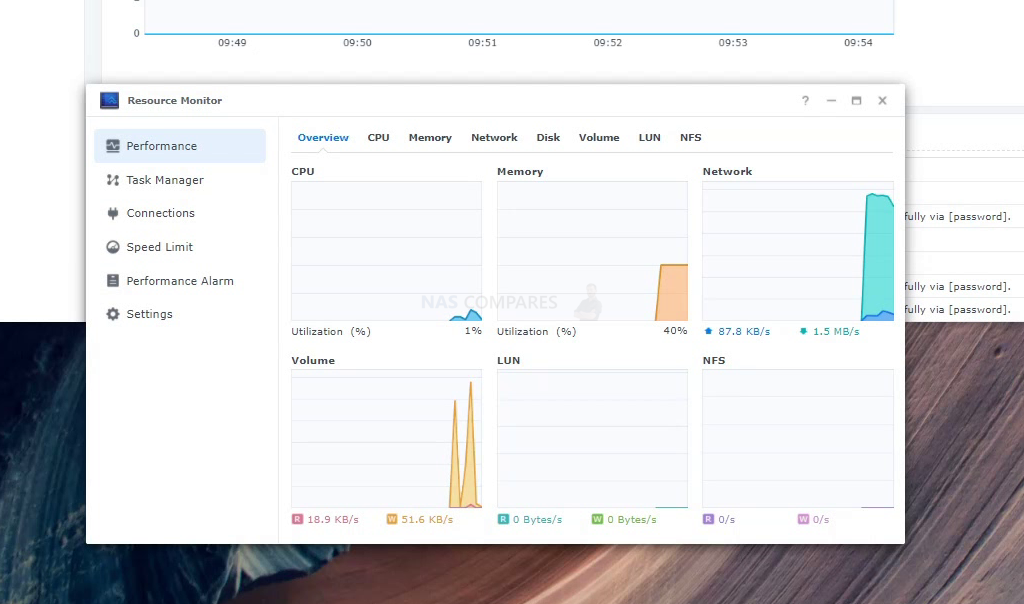
Talking of system hardware, it is worth discussing another area of DSM 7.0 that some are less happy with. The USB support (i.e the range of compatible USB devices) that you can connect to a DSM 7 enabled NAS is far less than previously, with numerous network adapters, office hardware and lite client devices no long being supported. Synology has highlighted that in some cases this is because they need updated drivers/software from manufacturers to work with DSM 7.0, but in other cases, we have already seen a trend of reducing compatible USB devices on Synology DSM. Luckily the majority of USB storage devices are compatible (2 connected in the image below), but EXT3 is no longer supported in DSM 7.0.
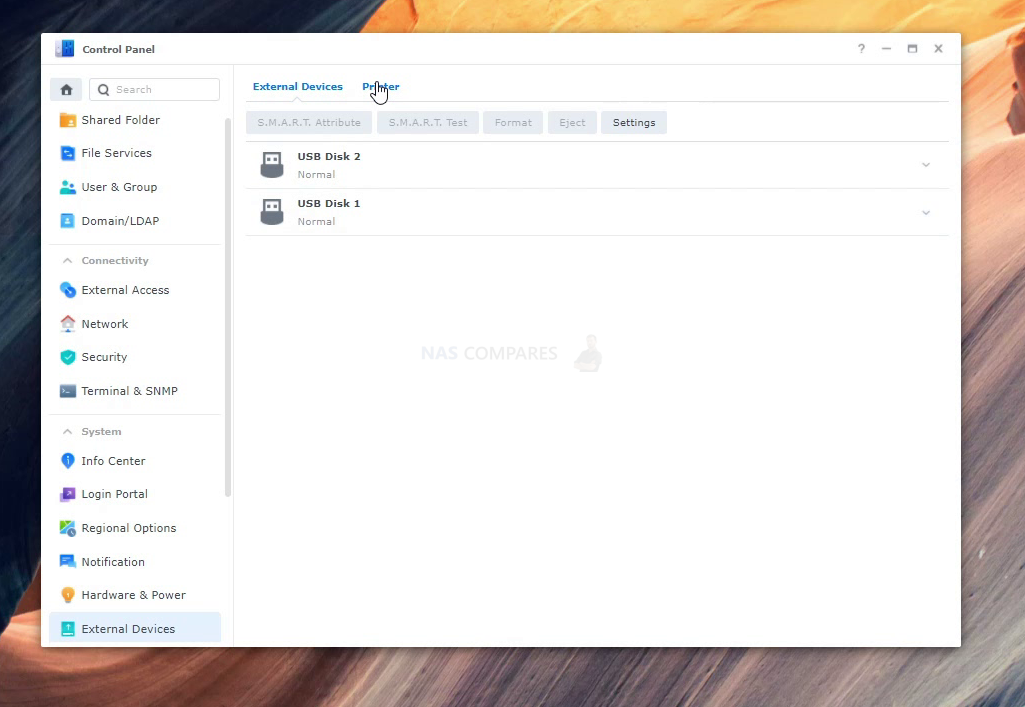
The system also has improved logs/records windows that are available to track the goings-on within the system and has incorporated a lot of this into the security center – providing updates/notifications to the end-user to pre-empt any potential vulnerabilities that open up.
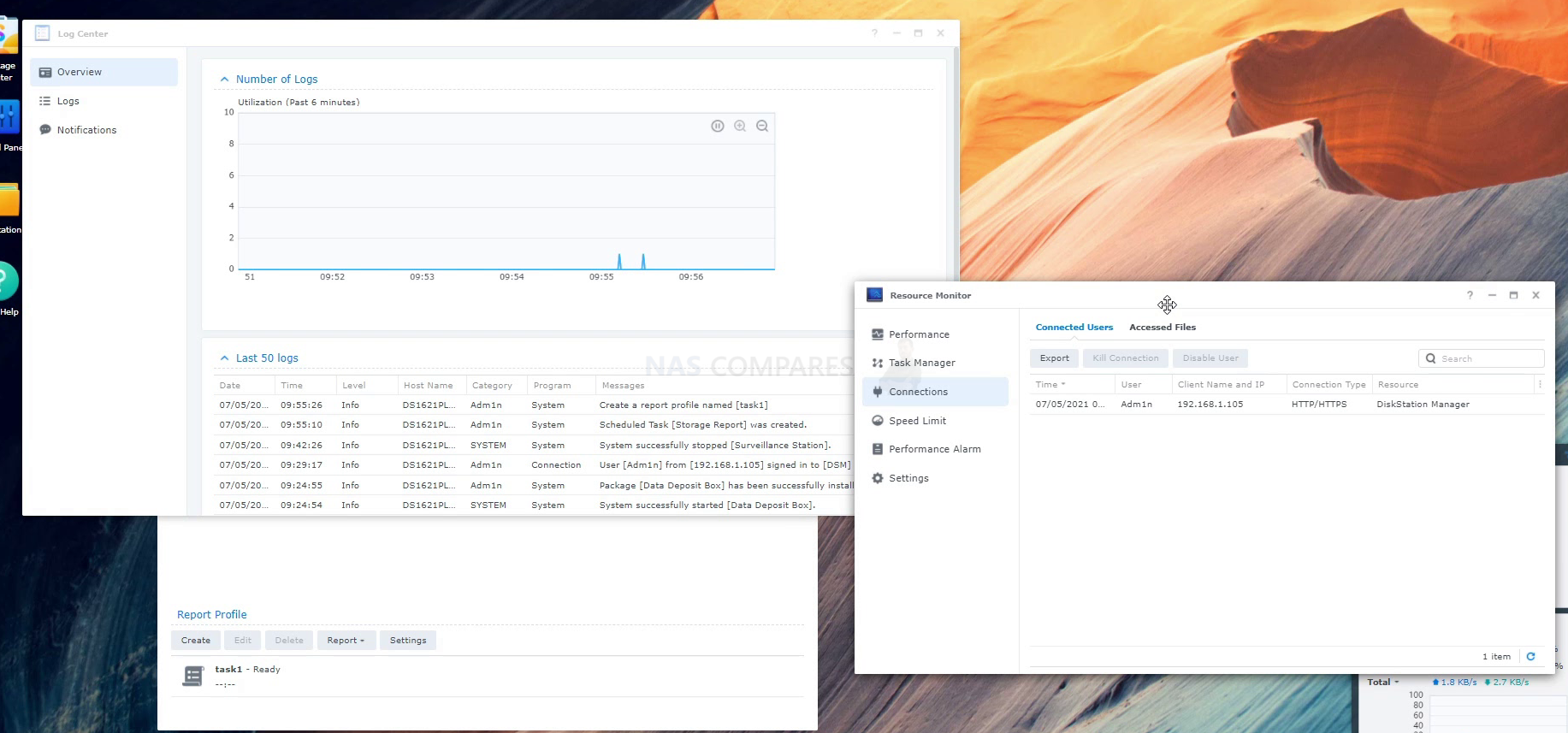
Along with numerous backend improvements in DSM 7 and the improvements of encryption in a bunch of areas, the system still has the same Security Advisor and Antivirus scanning systems built into the software. These can be set up the first time and then can do their high on a schedule, regular as clockwork. They seem a little thin on details, but they do their job and that’s what counts.
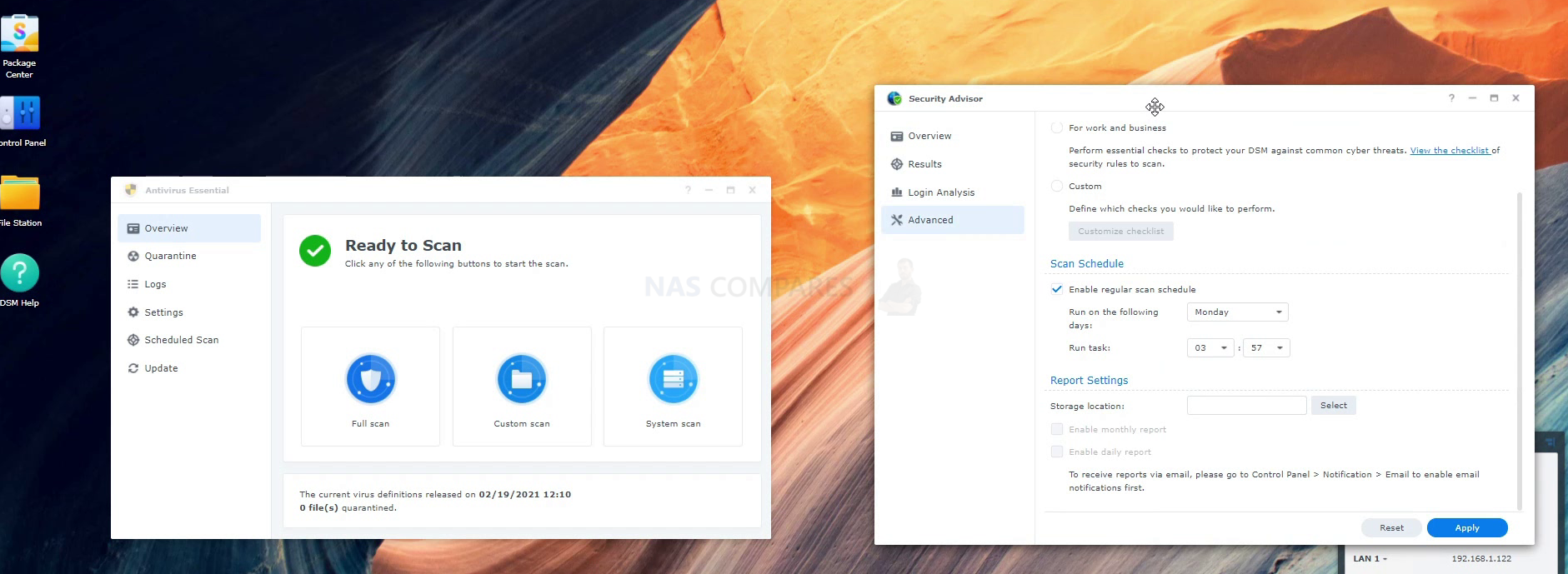
All in all, the user interface and interaction with Synology DSM 7.0 is a big, big upgrade over DSM 6.2 in design and responsiveness, though there is the occasional blip where you can see the layout/structure of DSM 6.2 at odds with DSM 7.0 – but this will likely be ironed out as the bulk of Diskstation development shifts over to DSM7 exclusively. When we first explored the DSM7 GUI and system interaction at the beta stages (video below) the clear improvements in operation speed and latency were clear:
Synology DSM 7 Review – Storage & File Management
Moving aside from shiny graphics, modern UX and responsive browser access, let’s take a good look at the storage and file management of DSM 7 and what has changed from DSM 6.2 The storage manager in DSM7 has been given a lot of attention, with the overview being given a large graphical overhaul. The more topographical list of storage pools, volumes and SSD cache bays is exceptionally clear and gives you the bulk of important information you need to know immediately. On the whole, I much prefer this new UI in the storage manager, however, I did notice that the layout of the NAS storage bays and SSD cache bays would only display correctly if I was using a web browser at 90-100% screen size. Anything less (as I believe most people use 70-80% on Laptops and MacBooks) and the SSD cache bay would display incorrectly.
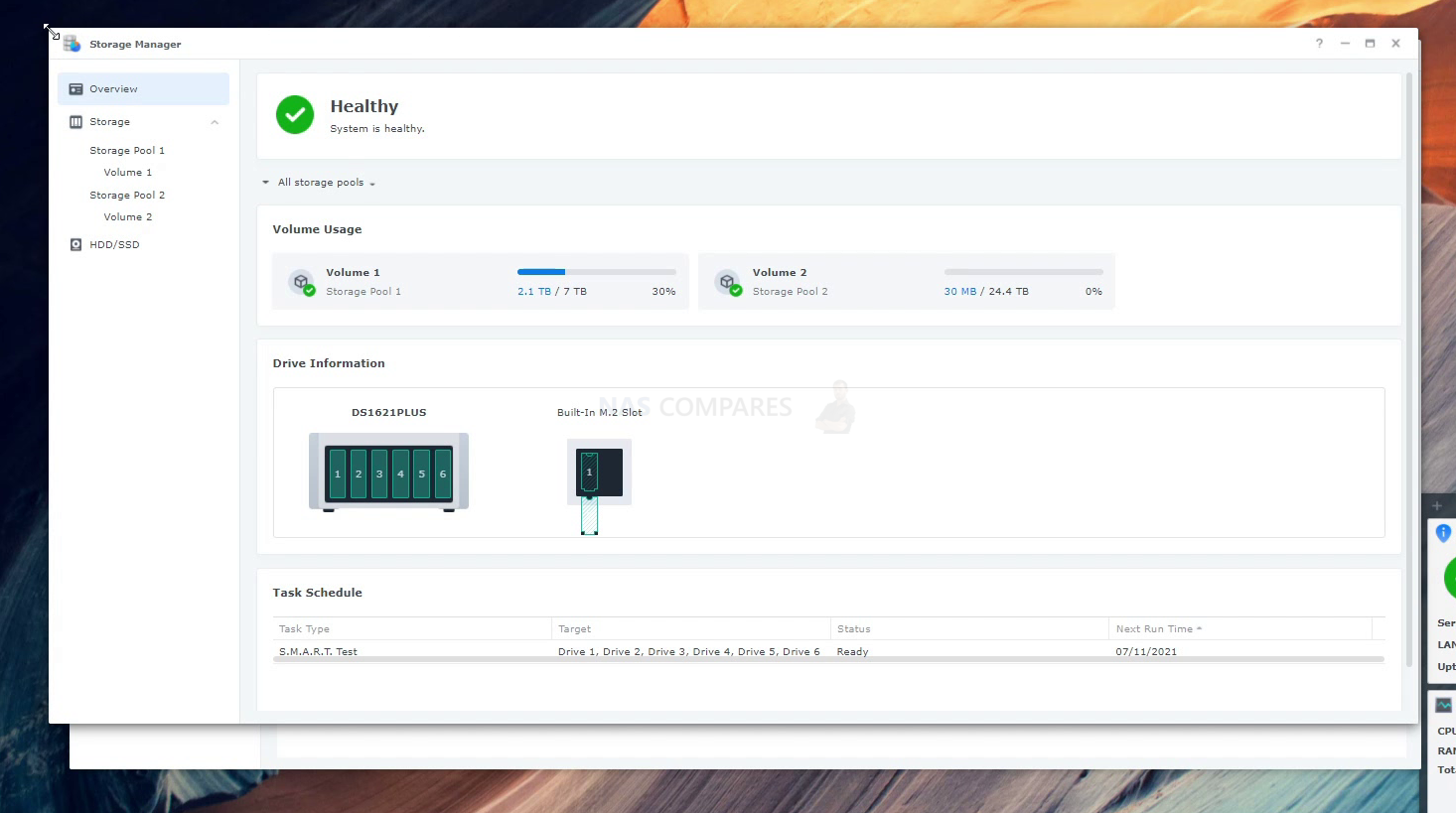
Changing the zoom (tested on numerous browsers) to closer to 100% would resolve this, but it does seem like an odd thing to have missed at the design stage. Still, it is an incredibly pedantic point I know!
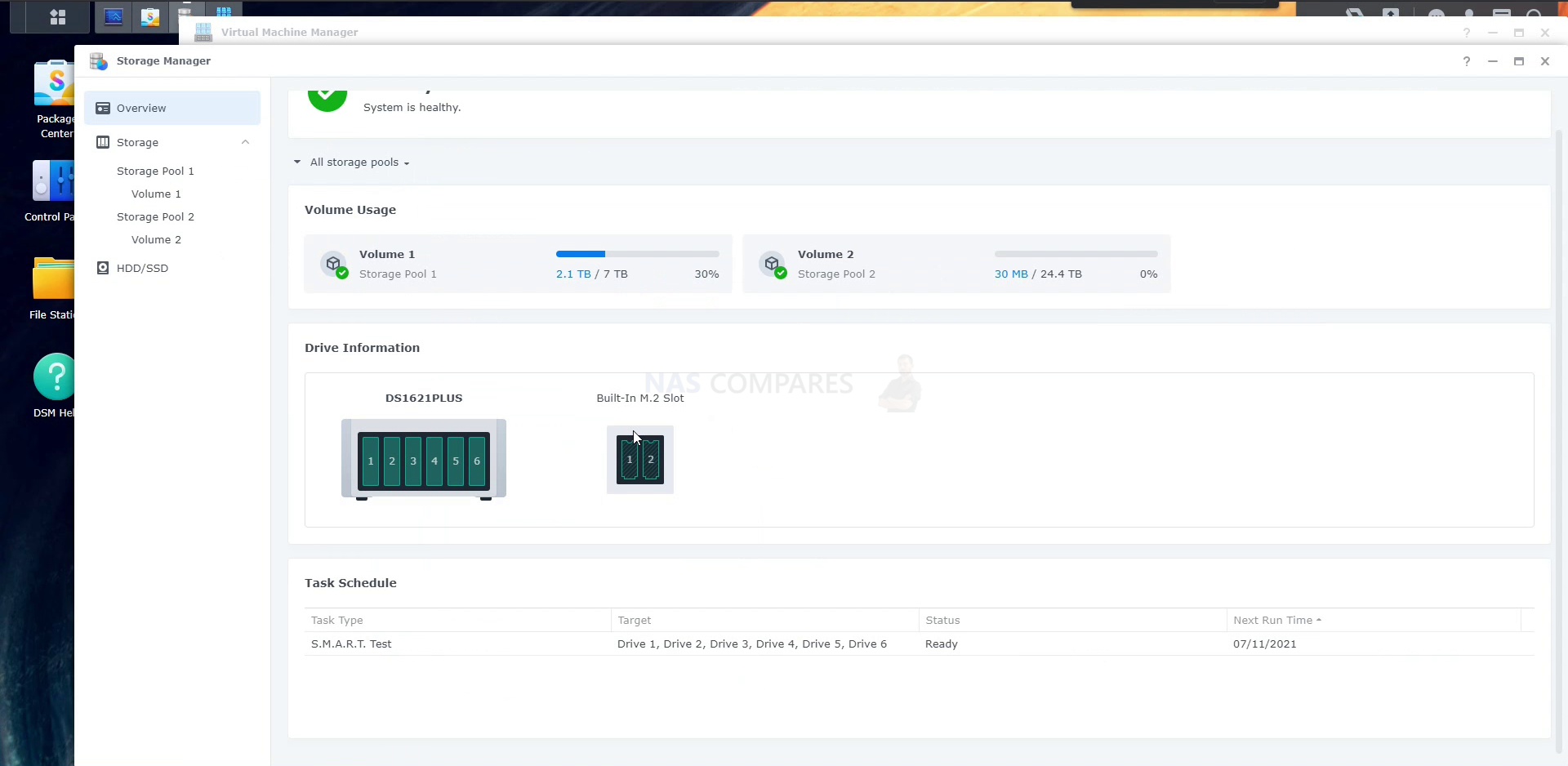
The drives tab shows us a slightly more familiar list that shows us the available storage drives on the system, along with SSD caching bays (as appropriate to the NAS hardware) and from here you can find out a wealth of information on each drive.
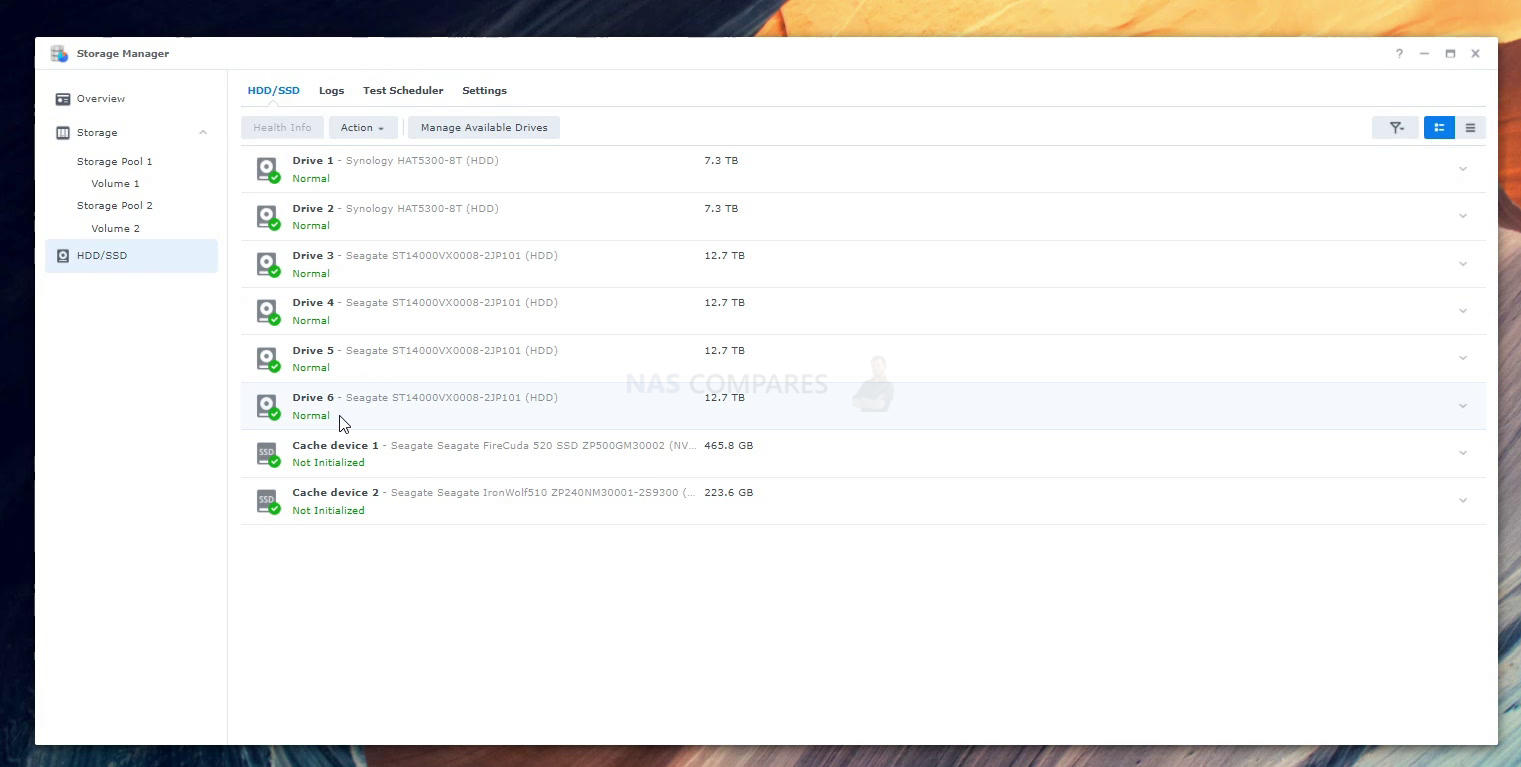
Information on each drive includes its health, SMART tests, temp, initialization status, model ID, serial, RAID group and much more. Once again, if you use Seagate Ironwolf Hard Drives, you have the option of utilizing the Health Management tool too.
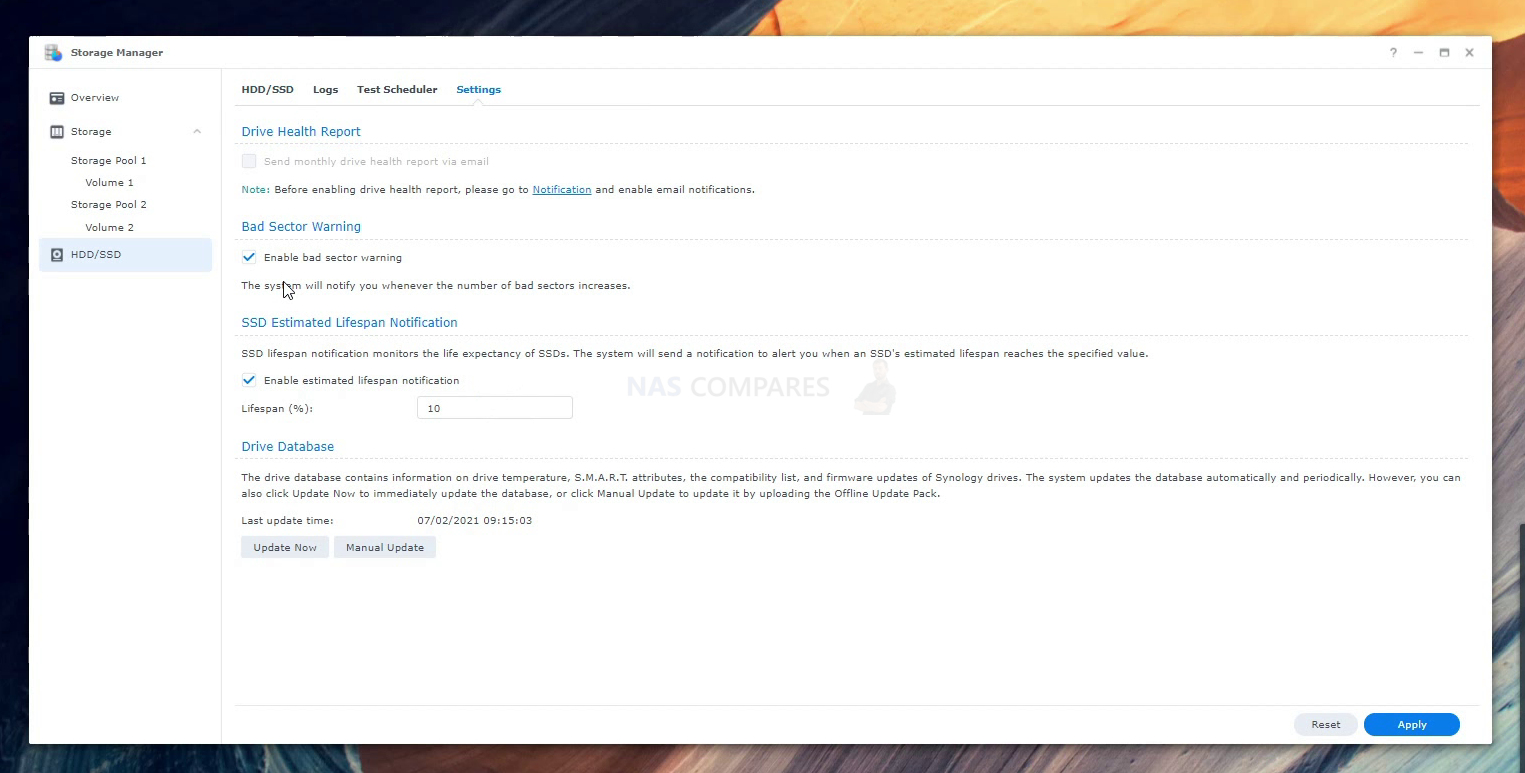
Once Hard drives are configured to a RAID (and yes, Synology Hybrid RAID is still an option on plus series devices and below), you can then examine a lot of the newer options of DSM 7 with regard to RAID management and how extra drives are handled. The has already been a lot of mention of the RAID 6 performance when degraded/rebuilding in DSM 7 (video tests coming soon), but there is also the new fast repair option that allows users to only have to factor the build of areas of the drives where data resides. In practice, that means that during a RAID rebuild, the areas of the drives (As dictated by the parity blueprint etc) that contain data are built, and the rest is just zero’d (whereas a normal RAID rebuild would build each block one by one, even the empty ones). This is also joined by the already available RAID resync/rebuild priority control to allow the scaling of resources as needed.
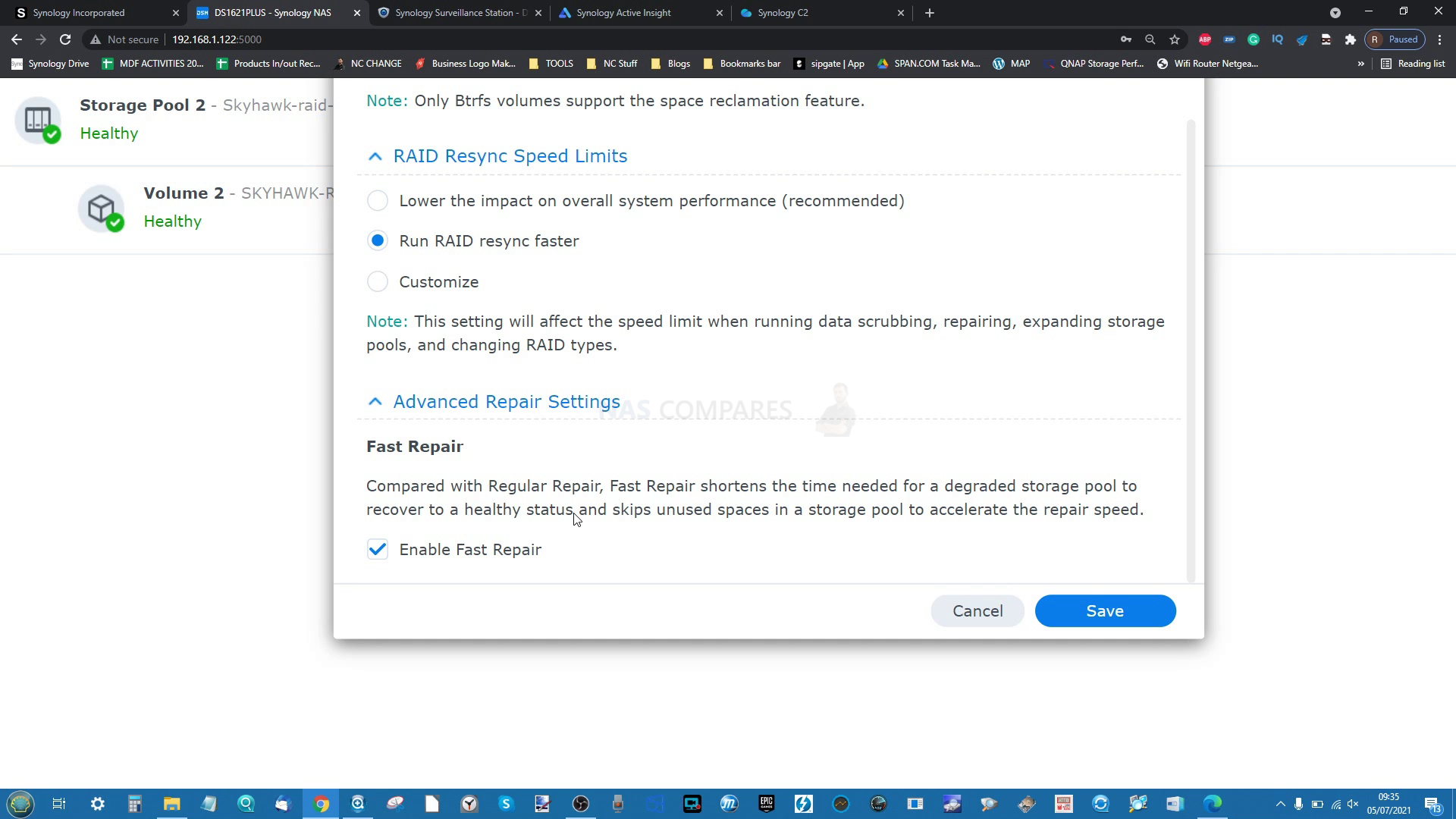
In the event of a new drive being inserted into a NAS with DSM 7, there is an improved display of options of what you can do with this drive with the existing RAID array, making the initialization of a drive to the system much more intuitive and easy to conclude.
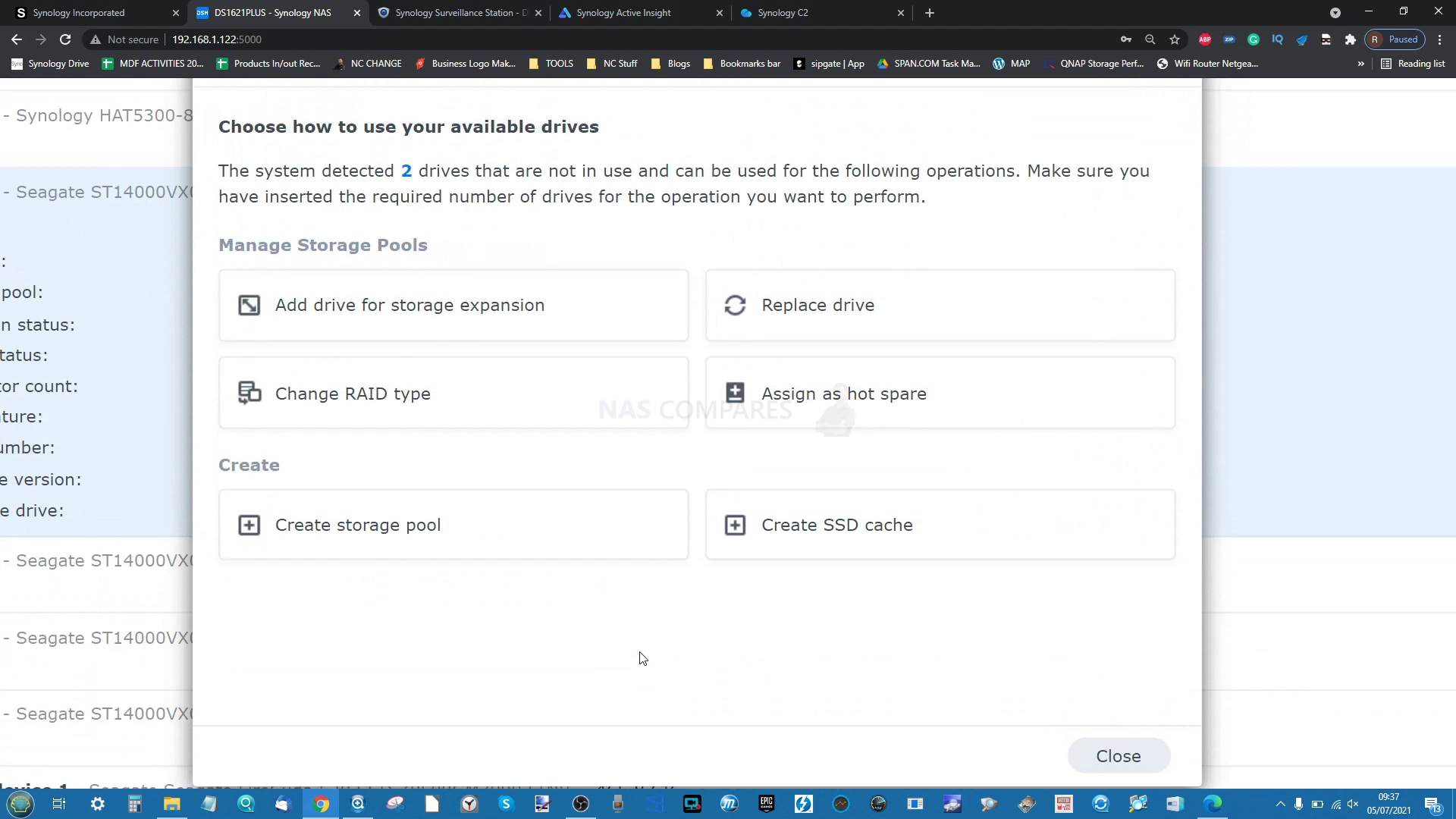
Outside of the storage manager, when it comes to interacting with your NAS, its volumes and contents at a file/folder level, the File Station application still provides all the functionality you are going to need. Perhaps looking a tad dated compared with other DSM 7 improvements in UI and the Synology Drive application, but still a very functional tool.
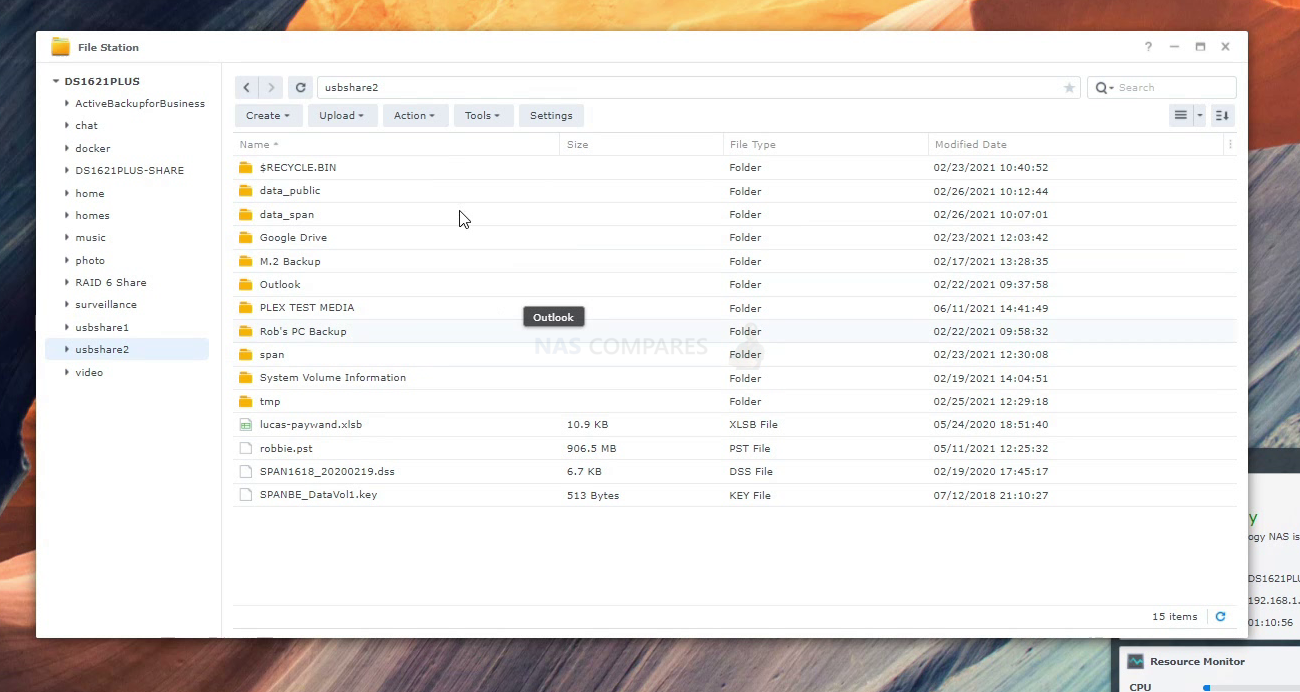
You can still create, control, modify and clone shared folders very quickly and this is still especially true on BTRFS systems – as well as when mounting C2 cloud storage using the Hybrid Share application (covering later). Though I would also highlight that DSM 7.0 requires at least 1GB of memory to fully utilize the system software smoothly and although it IS available as an update to more modest hardware systems like the DS120j (512MB memory), if you are running a DS218play and above (2GB memory) with DSM 7 and BTRFS, I would expect resource utilization to rise up notably.
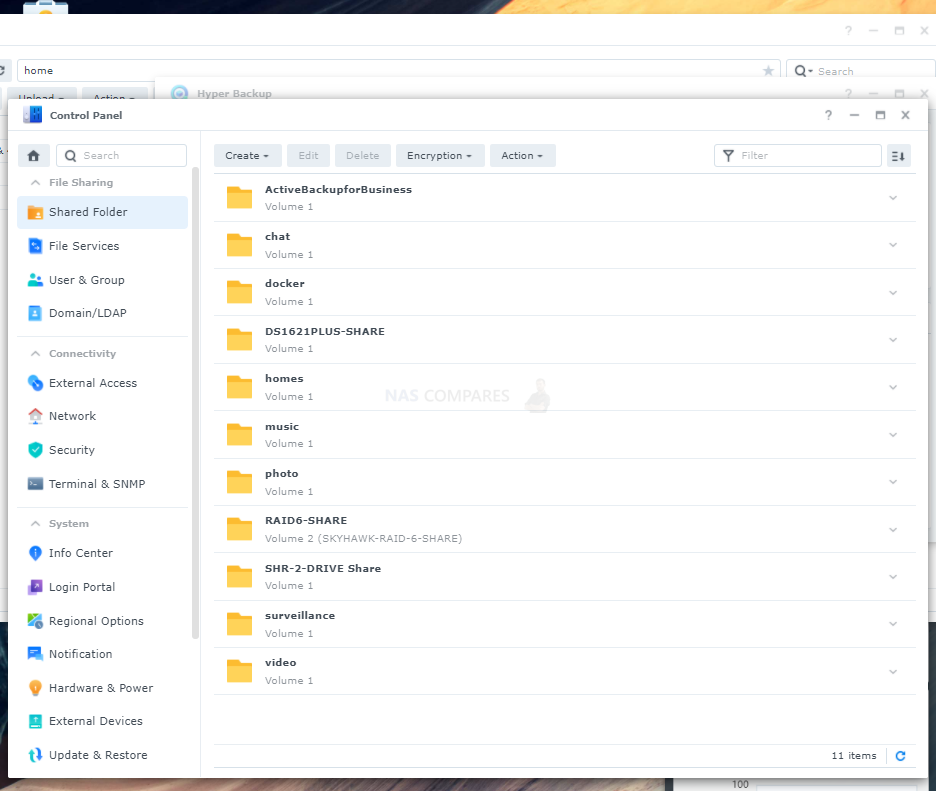
Another change that is mostly cosmetic is the change by Synology in making the iSCSI Manager tool (for creating logical targeted storage on the NAS that can be added to remote client systems much more natively) into SAN Manager. The integration of SAN tools into NAS in recent years has grown dramatically and although SAN manager and iSCSI Manager are mostly the same in utility and layout, they have made a few changes to the available options and defaults that make it easier to create your next business target and LUNs.
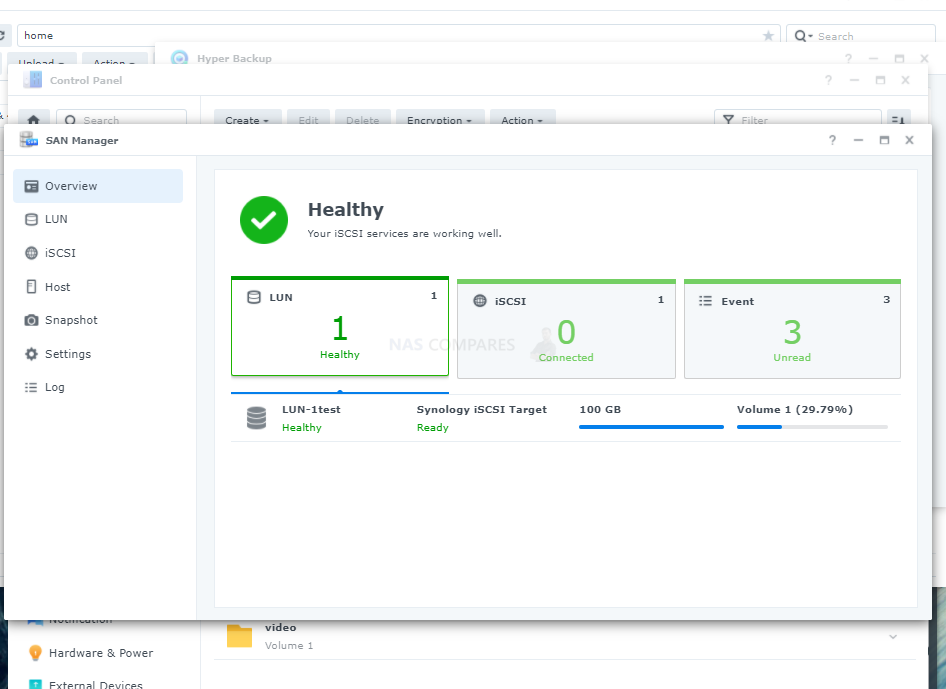
Synology Drive is another application that has changed very little in design between DSM 6.2 and DSM 7, but that is more likely because it has already evolved significantly in the last few years. Originally promoted as the Synolgoy NAS based alternative to the 1-portal UI available in Google Drive and Dropbox (i.e 1 window, can option all/most file types), but has now become a behemoth of a tool for home and business users to backup, sync and access their NAS in a far, far more native way. As mentioned earlier, its design is far, FAR more preferable to that of File Station and it would have been nice to see a similar level of design and access be afforded to File Station in DSM 7.0 as found in Synolgoy Drive.
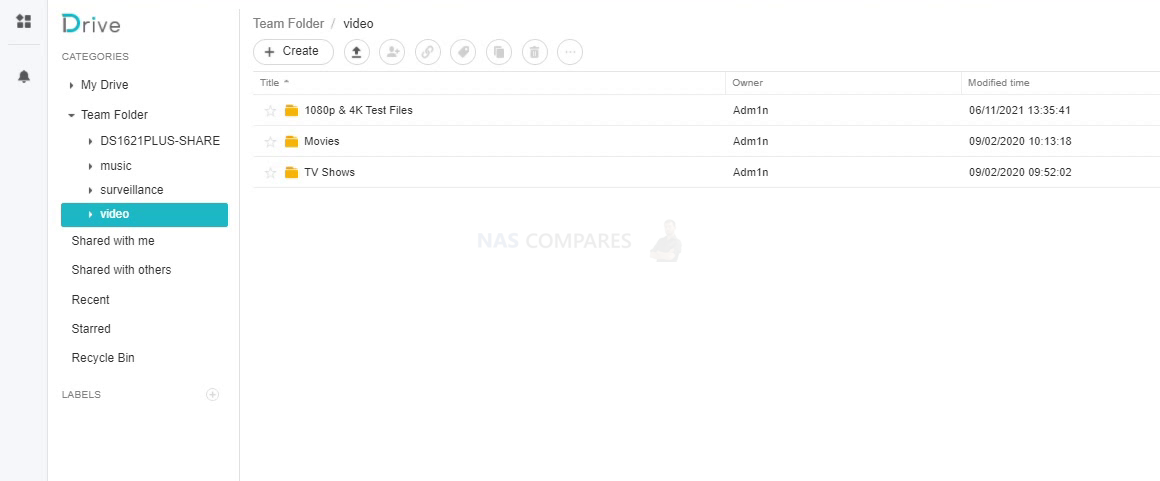
The client application for Synology Drive (that you install on your client computer) allows you to sync folders between your NAS and your system and allows you to interact with your NAS data (multiple users can share team folders too) without the web browser and inside your own native computer OS. However, the popular file pinning and file streaming on-demand feature is still only available on Windows client machines and although there was mention of support of Mac OS in DSM 7 in 2021, this is still yet to arrive (also the same for Mac OS support in Active Backup Suite).
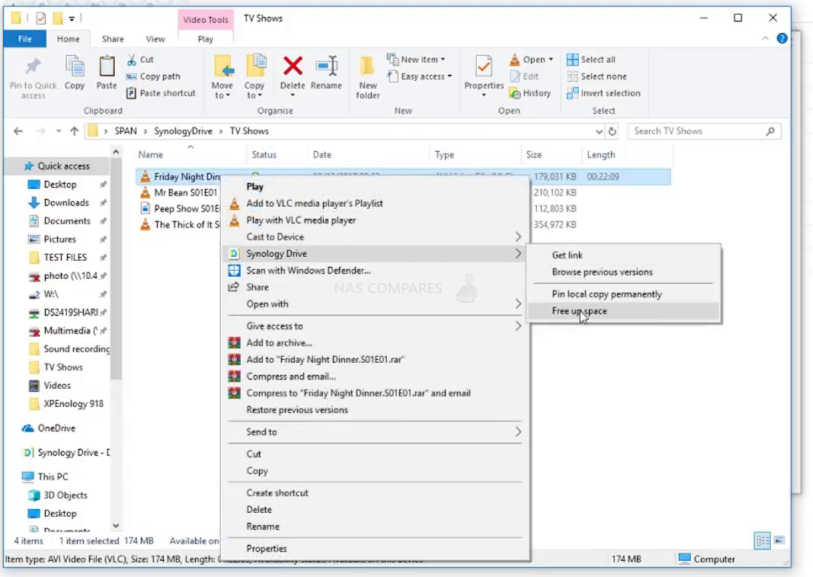
For those users who have made the jump from Google Drive and DropBox and onto Synolgoy NAS, the Synology Drive Client app and those additional file management services in Windows context menus are incredibly popular and it is a shame that the Mac OS functionality was not ready at release. Here is a video below (base don DSM 6.2) that gives you a better idea of how file pinning and file streaming on Drive works.
Synology DSM 7 Review – Multimedia Management
For those of you who own a Synology NAS or are considering making the move towards the brand for your data, the applications, services and support of multimedia on their platform is impressive, if a teeny bit rigid. Synology has a dedicated music management tool (Audio Station and iTunes server), dedicated video tool (Video Station), and photo management tool (Synology Photos). There is also multimedia extension add ons, media server extras and a few service extras, but in DSM 7 the only real BIG change is the move by the brand to consolidate the photo tools ‘Photo Station’ and ‘Moments’ into a single tool, Synolgoy Photos.

It would be fair to say that Synology Photos’ design is much more influenced by Synology Moments before it, but whereas Moments were a much more simplified album/strict-folder interface, Synology Photos has a little bit more customization available in terms of that albums and folders that are available to view. This is done by the Synology Photos app having a 2-Door/tab system for personal space and shared space. The former being your personal photo collection and all of the browsing, categorization and customization that you would expect. The shared space however will show the individual photos/albums/collection that you are sharing. This is much more familiar to Photo Station users, with a control that allows professional photographers and business users to craft and control the images they share.
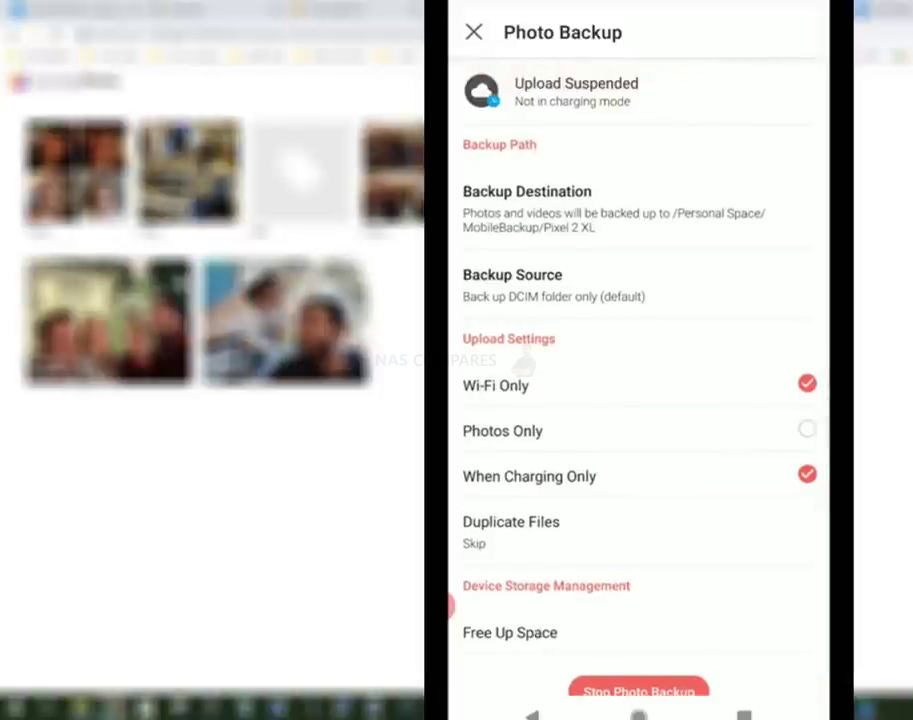
Synology Photos is a very impressive upgrade over Synology Moments (which always felt like had its wings clipped so it would not cross over Photo Station too much), but many Photo Station users how raised complaints about the simplified UI of Synology Photos. Likewise, the design of Photo Station seemed to resonate better with professional photographers, compared with the more chewable/easy Moments UI – so the fact that Synology Photos has heavily embraced the latter design has ruffled a few feathers. Equally, the slightly more restrictive target folders that are used Synology Photos is the same as Moments/Photo Station before it and in most cases, you will need your albums to reside in pre-designated areas of your NAS storage (you cannot tell the app to ‘index from X location’ easily). Likewise, a few of the AI-powered functions and menus are required to be manually turned on at the first time app launch, which seems an off choice.
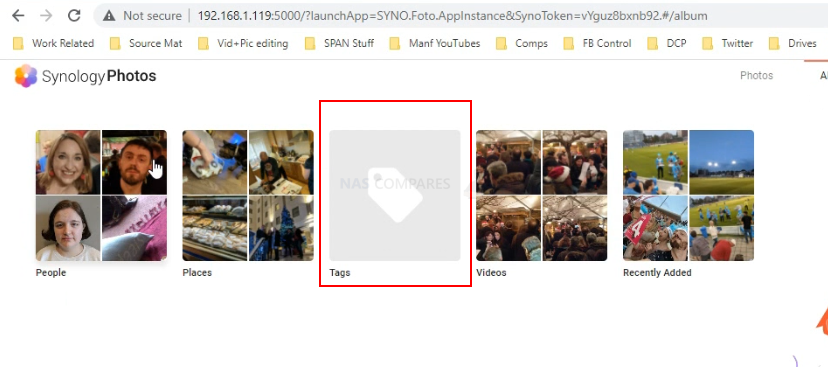
That said, Synology Photos is still a big, BIG jump over Moments and the amount of information in the photo metadata that you can pull in the app is SIGNIFICANTLY better. This information, along with photo tagging can be used in the new improved filter search system to a noticeably high degree, not only to find photos a great deal more precisely but also to immediately reach smart albums based on those search results. So, for example, you can search for photos that MUST contain photos of person X, Y and Z, but have to have been taken between data A-B, on camera C, in location D – not only will it spit the results out to you very quickly from your collections, but you can then create a brand new photo album in 2 clicks from these results. VERY handy.
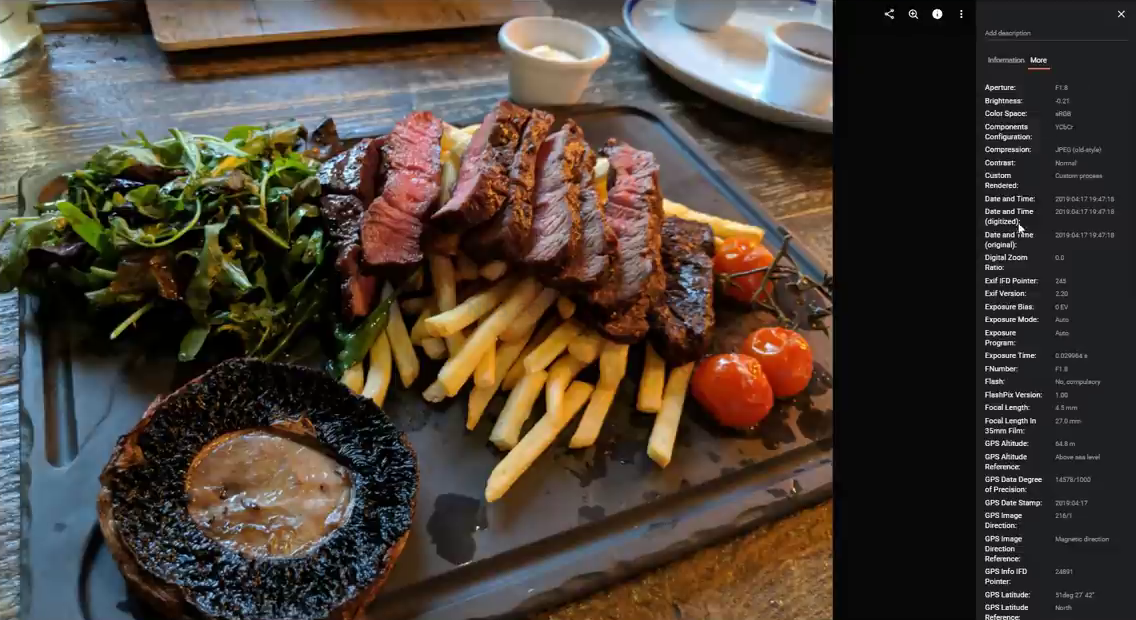
The AI-powered photo recognition and people, faces and things are still available in DSM 7 and do not require an internet connection in order to operate. Though it and the Subject recognition were areas where the visibility of these albums needed to be activated on the menu (odd choice) and I am also pleased to confirm that not only did it do a good job, but photo data was carried over from the DSM 6.2 system before.
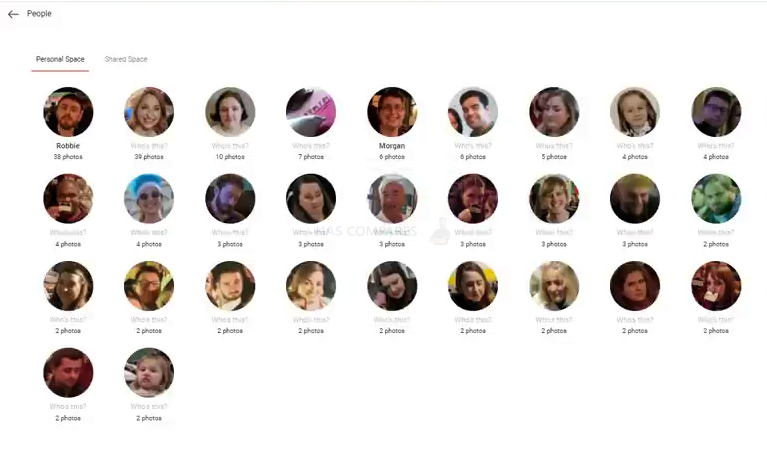
We have discussed Synology Photos at length when the application was included in the DSM 7 beta and the core system build remains the same in this new full DSM7 release. You can find out more on Synology Photos in the video below:
The rest of the media applications in DSM7 have not really changed much since DSM 6.2, but this is by no means a bad thing. Synology is still one of the only brands that have a 1st party application for Amazon Firetv (DS Video, DS Audio and DS Photo for Native NAS access from your sofa) as well as a 1st party application/skill for Amazon Alexa (DS Audio) for voice-activated audio playback. They are all very good applications and still very much some of the best you will find in NAS in 2021/2022, but I will highlight that the UI of Audio Station is long overdue for an upgrade, as it already looked a bit ‘Winamp’ and in DSM 7, the conflict between DSM 7 design and Audio station is pretty glaring.
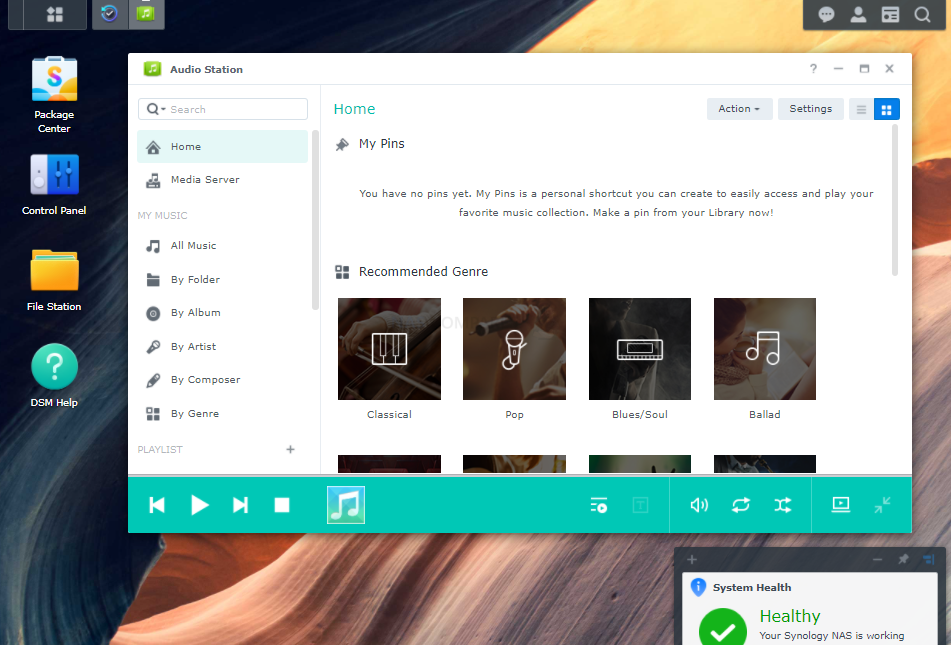
The video station application on the Synology NAS platform is still first class, giving the likes of subscription access on Plex Media Server and Plex Pass a run for their money. DSM 7 has not changed anything by the looks of things and the UI on your browser still opens in a new tab outside of DSM7, as it did in DSM 6.2.
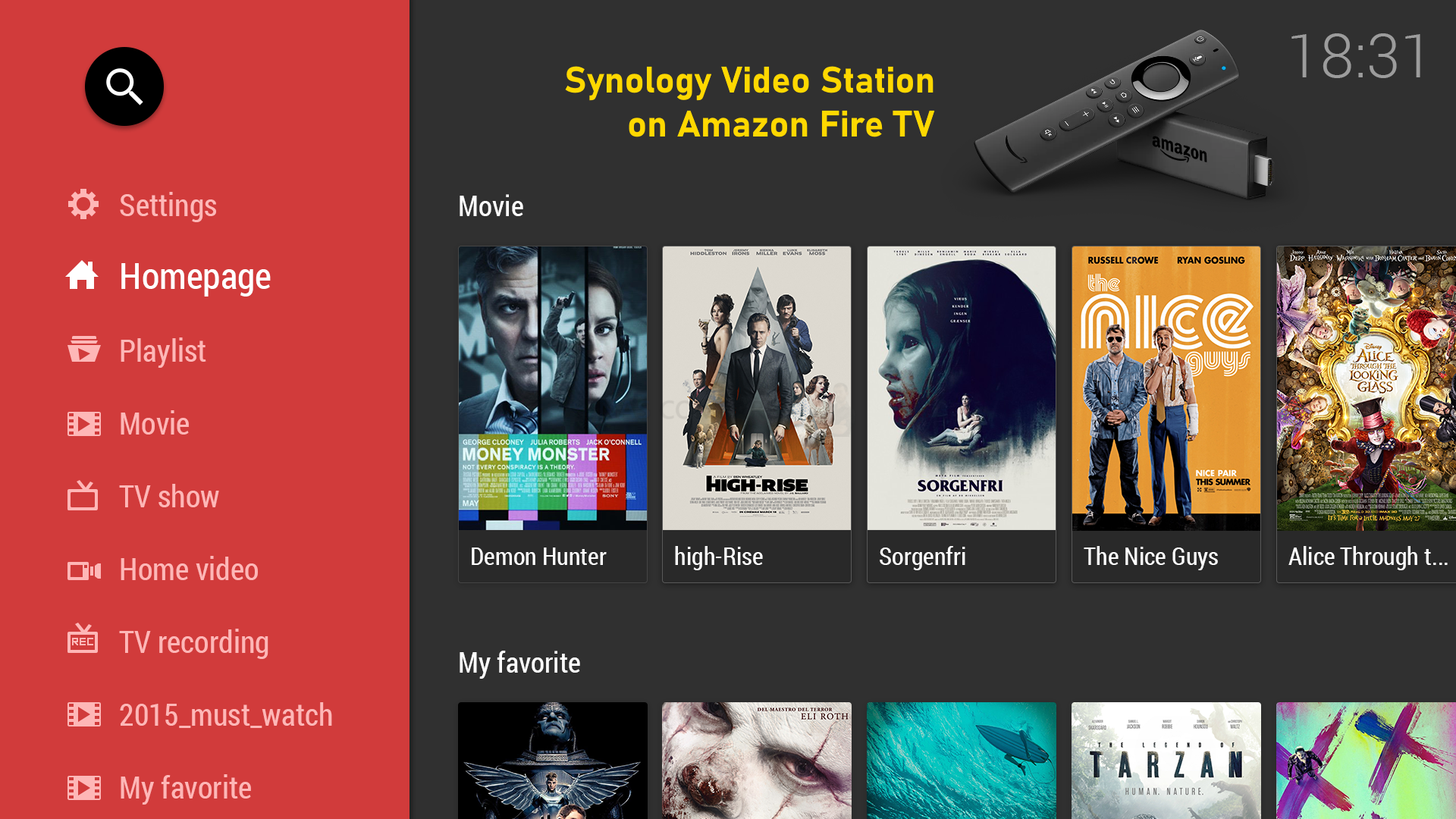
The only minor point I would raise is that Synology Video Station on DSM 7 seems to require the IMDB/Movie-Database API key a lot more readily than it seemingly did in DSM 6.2. I have tested Synology Video Station on numerous occasions and always using the same media files, yet in DSM 7 the metadata was not scraped automatically as it has done previously. This could well be an oversight on my part whereby metadata on media in DSM 6.2 NAS scenarios was already on the disk, but I am less convinced – currently investigating.
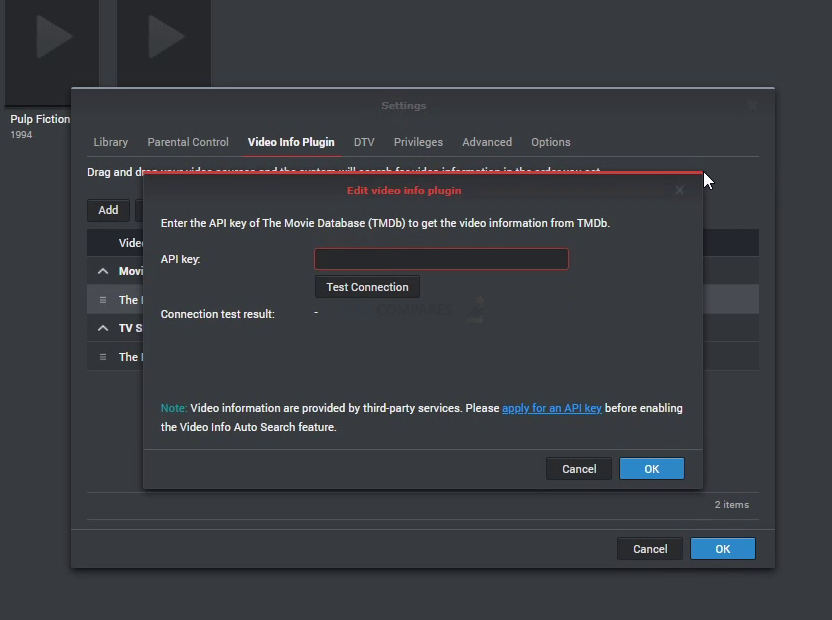
Nevertheless, DSM7 has still got fantastic support of multimedia on the Synology NAS platform and aside from a few niggling areas of complaint in the Audio Station GUI, Photo Station upgrades and that API key issue in video station (still possibly an issue on my side, so the jury is out!), DSM 7.0 still keeps it smooth as silk!
Synology DSM 7 Review – Backups, Backups, Backups!
Most people buy a NAS system for backup purposes so that all the data on their PCs, Laptops, Phones and tablets is all safely contained in another location. However, all too often as soon as space becomes limited on their client device, they start deleting files feeling that it’s ‘ok, because that data is backed up to the NAS’, however now that data is no longer a backup, but is the ONLY copy of the data they have! That is not a backup and that is why most NAS devices arrive with numerous means to back up the data that is inside the NAS to a USB device, another NAS, another area of the same NAS or onto a cloud platform – so that they have ANOTHER layer of backup to rely on. DSM 7 features ALL of the backup options that are available from Synology on DSM 6.2, as well as presenting them in a slightly tidier way. There are very few new features and functionality extras in DSM7 over DSM 6.2 (aside from how HybridShare integrates Synology C2 as an available storage area and the promised upgrades to Synology Drive/Active Backup for Mac OS later in DSM 7 development), but what is available is still very good indeed and scales well between home and business users. The original OG backup tool from Synology, Hyper Backup, is still very functional and covers a very wide range of backup targets/destinations ranging from local to cloud.
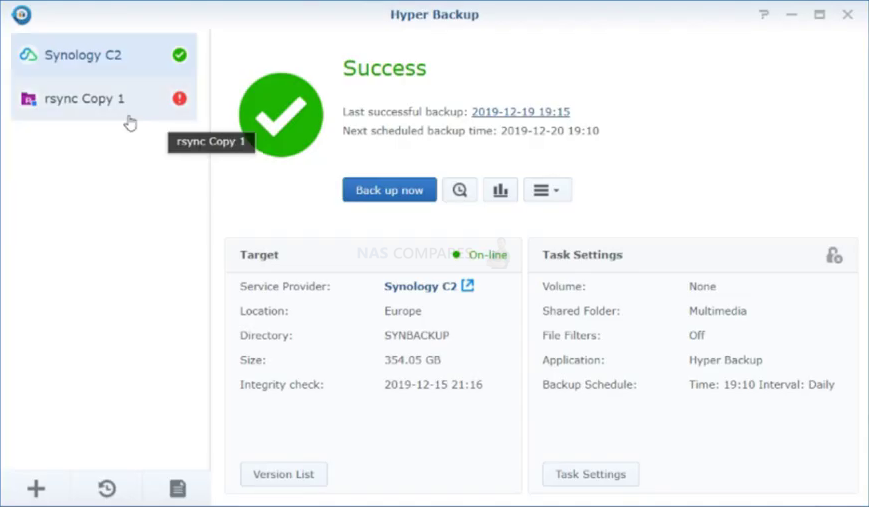
Hyper backup is (luckily) not restricted to Synology C2 (their own cloud service) in the range of cloud services that it supports, however the available cloud providers supported in Hyper backup does seem a little thin on the ground (only 4-5 supported cloud providers, in weaker contrast against the platforms supported in Cloud Sync later) and although there is plenty of general server backup options using rsync between NAS systems and iSCSI targets within Hyper Backup and other networks/internet systems (inc. WebDav thankfully), I am surprised at the small range of supported targets. However, Hyper Backup is still a VERY good tool and sits well in the hierarchy of Hyper Backup, Cloud Sync and Active Backup as your backup/sync demands scale-up.
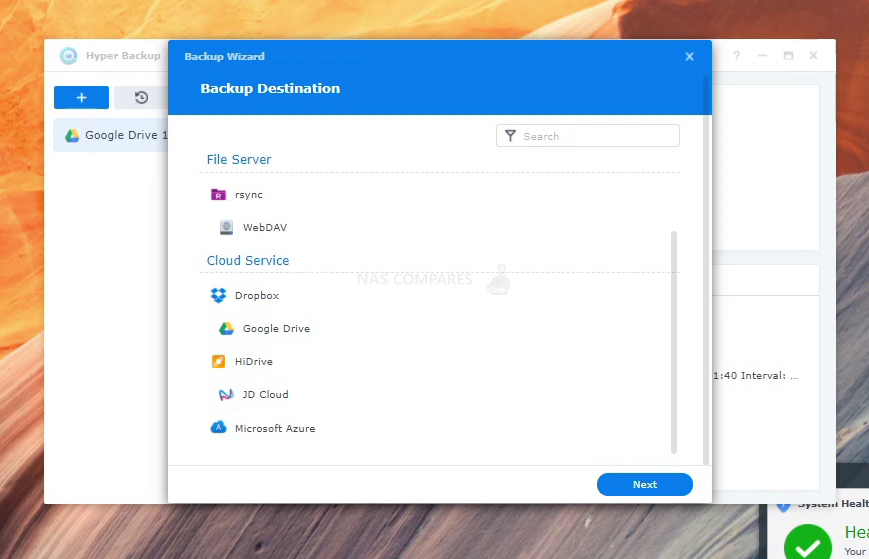
Moving up from Hyper Backup, we can look at the far more business targetted Active Backup Suite application that is a far more enterprise tool than Hyper Backup, acting as a single portal backup management point for your numerous physical/virtual client devices. As previously touched on, the support of Active Backup of DSM 7, although improved and expanded greatly with Software as a service platforms (SaaS), Virtual/Physical machine integration and 3rd Party servers, but the long-awaited Mac OS updates are still ‘TBC’ later in 2021/2022. I have praised Active Backup on DSM 6.2 numerous times and it continues to impress me in DSM 7.
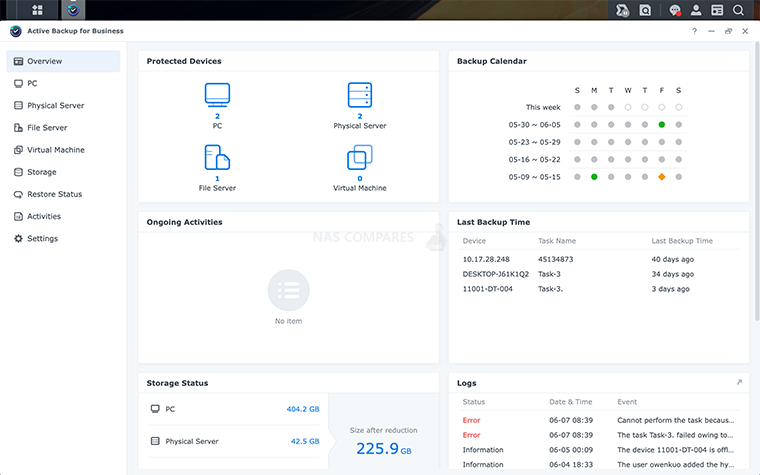
Although Active Backup is a License free software that arrives with your Synology NAS in DSM 6.2/7.0, it is worth mentioning that it does now require you to register with your Synology Account (again, this was apparent in 6.2), but this is perfectly fine and a constant internet connection is not required for its operation, just required for its registration. However, this will be impossible for users using Active Backup for VMware or Hyper V environments/VMs remotely for snapshots and recovery at all times.
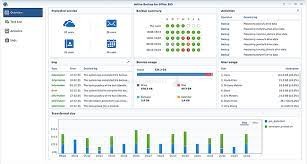
Another feature of Active Backup is that it can be used to support your existing Microsoft Office 365 and/or Google Workspace (formally G-Suite) services (file hosting, accounts, shares, mail, etc) to not only sync and backup those remote services locally in a native way, but also to allow access to them when your internet connection is interrupted/suspended and then synchronize changes when internet connectivity is restored. Once again, not a DSM 7 only feature, but still worth highlighting.

Finally, in terms of backup, although it is still possible in the Hyper Backup tool to a lesser degree, the USB Copy tool is still available in DSM 7.0 and allows a large degree of customization and rigidity in your local USB backup routine. Much like the Active Backup Options mentioned previously, there is a wide range of methods available that range from time managed backups and Differential backups (jsut the changes) to widespread versioning configuration, integrity checks and large filter control.
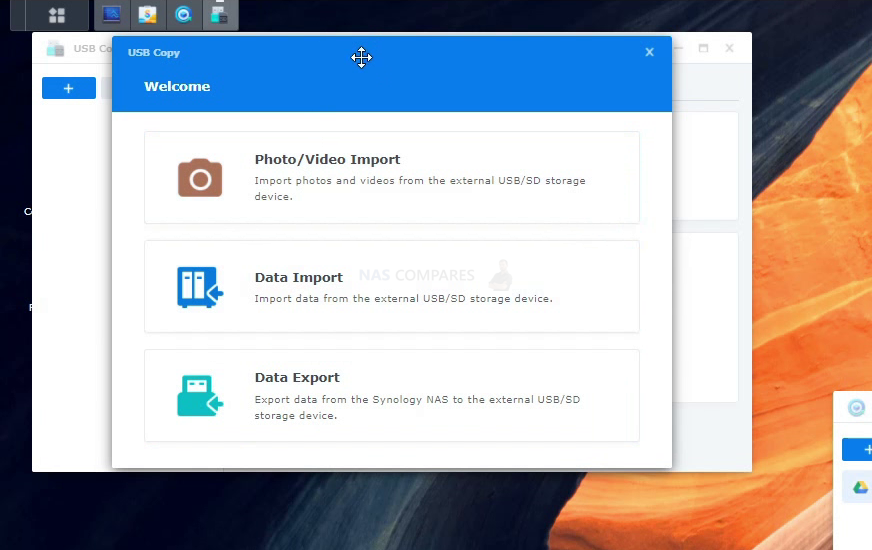
These three tools, along with the Synchronization tools that we will cover in the next part have changed very little between DSM 6.2 to DSM 7.0 at this time of writing, but are still MASSIVELY useful tools to those who bought/buying a Synolgoy NAS and want to know their data is safe. Below is a video that completely covers all of these applications and how they work together to easily create a multi-tiered backup strategy in minutes.
Synology DSM 7 Review – Cloud Storage, Gateways and Sync
Cloud gateways and the combination of internet-based storage services working together with a bare-metal NAS server is not new and in recent years we have seen a big, BIG increase of these services – especially as SaaS and PaaS (Platform as a service) has grown in popularity. The ease of accessing files on your existing cloud service provider (the simplicity etc) cannot be understated and although most of them lack the customization and bespoke security of a NAS drive, they certainly still have a place in home/business. Most NAS brands are coming around to the idea of providing their local/network/individual server systems into a parallel sync set up with Google and Microsoft cloud platforms (see Active Backup Suite earlier) but Synology is one of the ONLY brands in NAS that takes it once step further by supplying their very own cloud service in the form of Synology C2. Synology C2 Backup has been around for a few years now and although it was always an option in DSM 6.2, things are certainly scaled up in DSM 7.0. This is especially apparent in the new HybridShare application that allows you to bolt on the Synology C2 storage to your DSM7 NAS and then access it with the same level of localized/native control as you would your NAS RAID etc. This is done with intelligent caching and synchronization in the background of DSM7 and allows your C2 cloud space to be accessible by multiple users and other NAS drives, providing a secondary access point to the same area of storage.
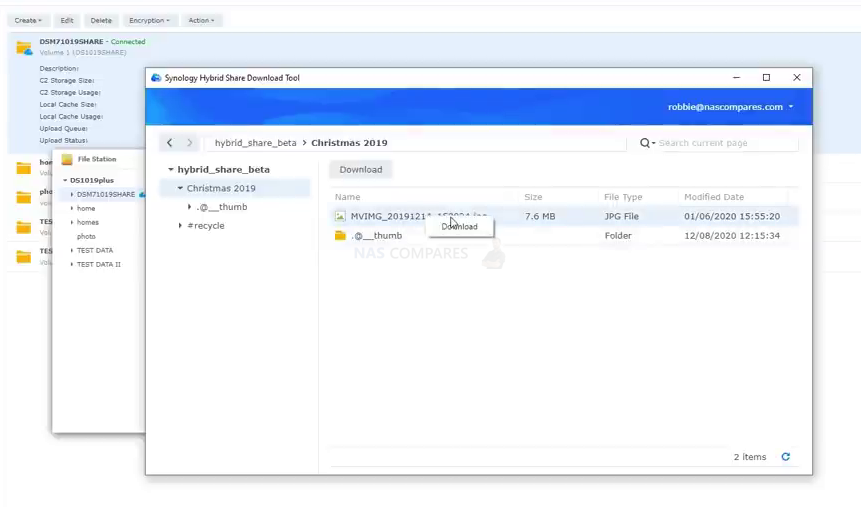
HybridShare is much like connecting Dropbox and/or Google Drive to your Synology NAS storage, however with C2 connected, you have a greater degree of control on versioning from the C2 portal and through your NAS. Likewise, C2 integrates better with your existing DSM 6.2/7.0 applications. However, I am still a little disappointed that HybridShare does not support other cloud services, as although this would limit the range of control options available to your Synology NAS, many business users may have active larger 3rd Party Cloud space subscriptions that they want to use in a more native way to the NAS (as HybridShare allows) and not just via Cloud Sync (which syncs the storage on 3rd party cloud, but limits the integration). This could be marginally mitigated if the Synology C2 platform arrived with X amount of space for Free with DSM 7/Synology NAS (eg 10-50GB for X years at launch to let users test the advantages), but as it stands you need to pay a subscription fee for Synology C2 at even the lowest capacity tier.
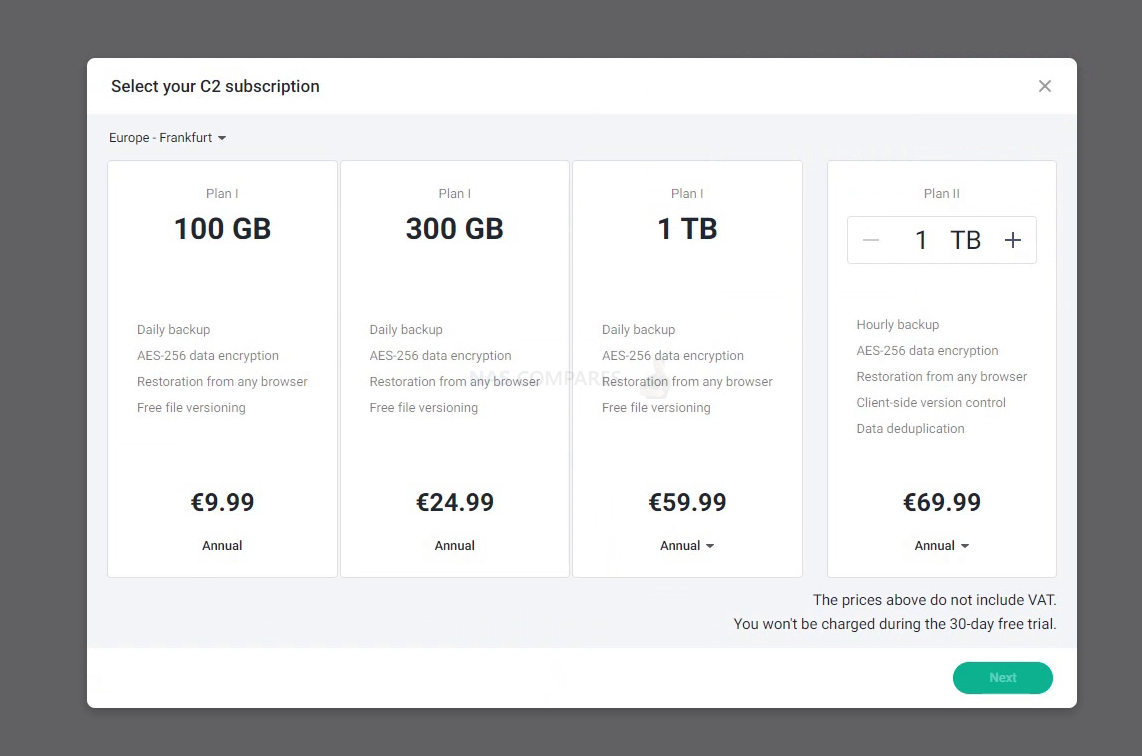
Features such as the versioning on the files that reside in C2 can be managed and restored without the NAS, a feature I genuinely like and will be especially useful when your C2 storage is pooled between multiple devices that are using Backup, Sync or HybridShare setups on multiple bare-metal Synology NAS.
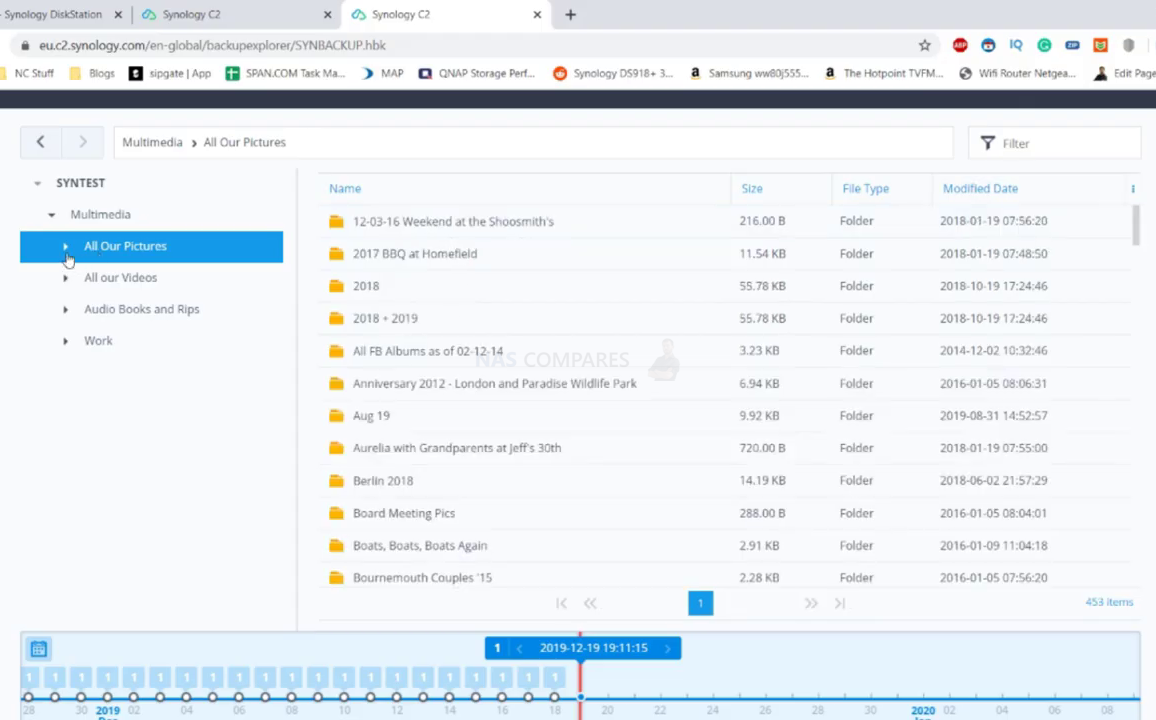
The Synology C2 portal is still a very good cloud service and provides a very good GUI via the web browser, displaying all the real-time storage information, synced devices and access logs. A noticeably jump on information available compared with 3rd party clouds at the Home/SMB level, but still a shame that it does not even have a free tier to slowly ease in users on Day 1, even in DSM 7.0 (which makes the most of C2).
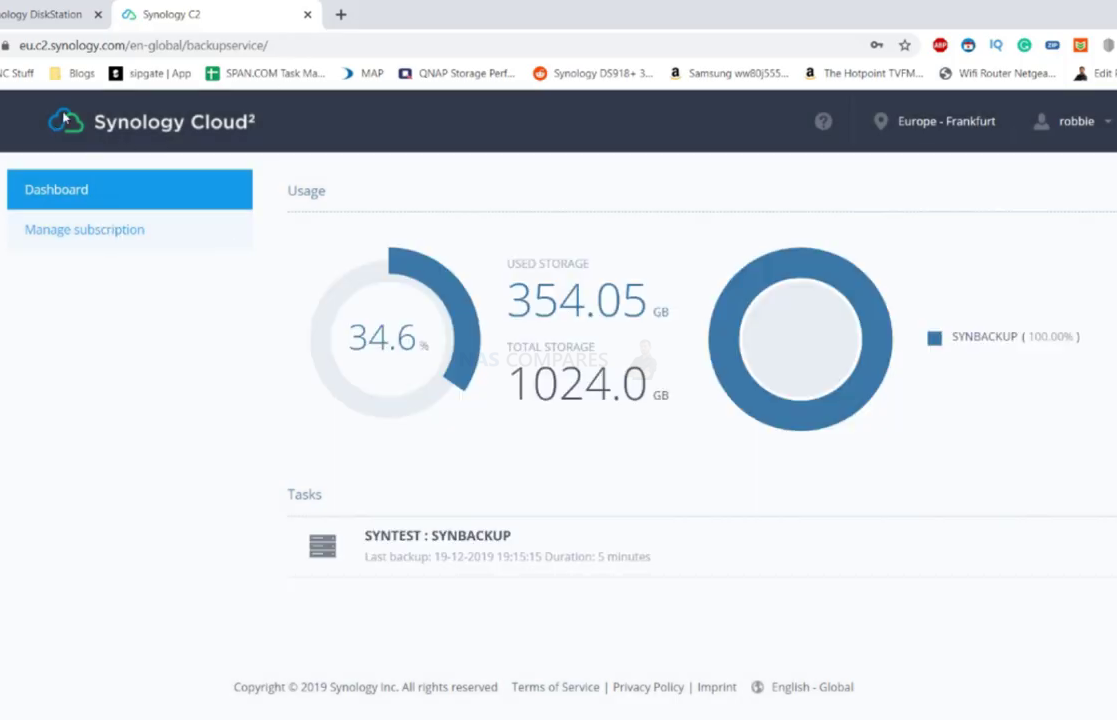
However, if Synology C2 and the improvements in DSM7 with HybridShare do not appeal to you, there is always Cloud Sync, which has carried over from DSM 6.2 and has a much, MUCH larger supported range of cloud services that you can connect with.

Cloud Sync is still a very versatile tool in DSM 7.0, even if it has had little change other than adding on those new services mentioned from C2/HB, with numerous filter options, version options (less detailed than C2 of course) and no limits on # of jobs/tasks you want to create and schedule with which you want them to run on. I hope that Synology does not choose to clip the wings again on cloud support later in DSM 7 in efforts to move users onto their 1st party ecosystem, but initial support on DSM 7.0 at launch is still good!
Synology DSM 7 Review – Remote System Monitoring and Management
Synology has always featured a bank of tools for remote monitoring their NAS hardware in DSM, with the Central Management tool (CMS) being the best tool for monitoring multiple NAS hardware systems remotely and check their system activity etc. In DSM 7.0, Synology has improved these control and access options to a wider network significantly and added numerous new options. However, the biggest upgrade on this score is Active Insight, a single portal access point to monitor numerous NAS systems all at once, to compare and contrast their behaviour, produce bespoke reports, receive health reports that are tailored to the Synology system history and help pre-empt failure/issues.
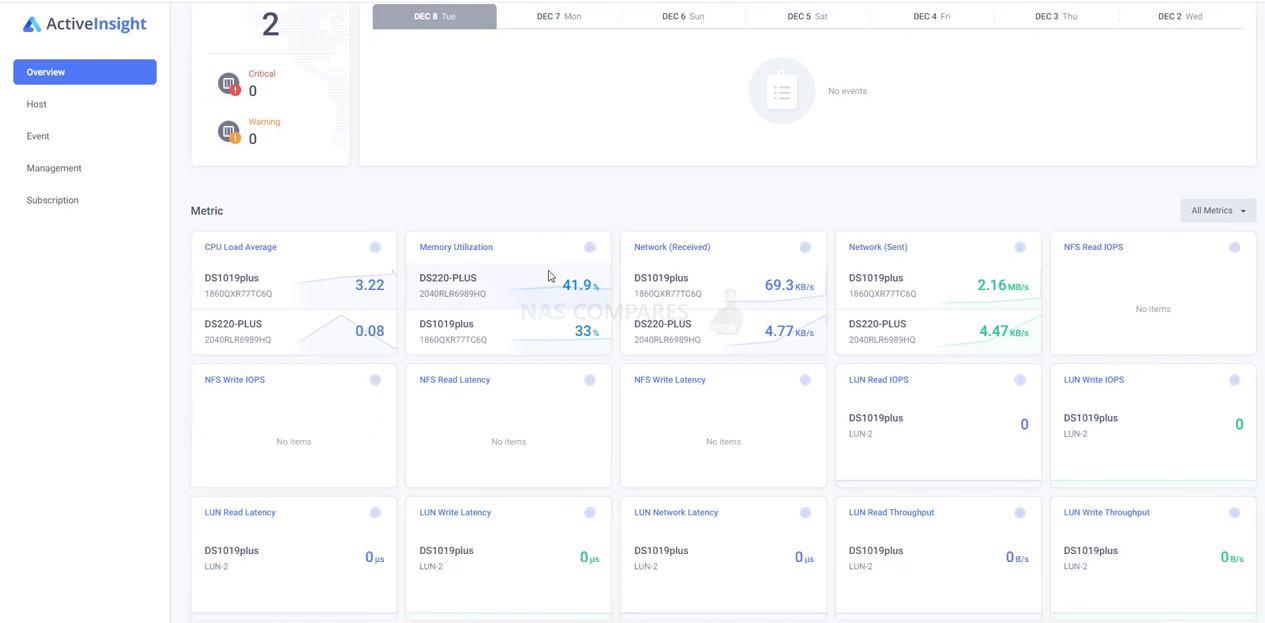
The service which has been running throughout the Synology DSM 7 beta earlier last year and into the RC version earlier in 2021, is now fully available to DSM 7 users. However it is not a free and inclusive service with your Synology NAS and much like Synology C2, does not have a freemium/inclusive X year subscription with DSM 7.0 – which does make it a bit of a leap of faith as a service in terms of business integration. It does allow you, once your subscription is started, to add a huge number of systems and create very, very bespoke alerts and access/usage stat reports that will be massively useful to any business that has a high data turnover at their respective branches but has a central IT/Data management team to oversee the lot.
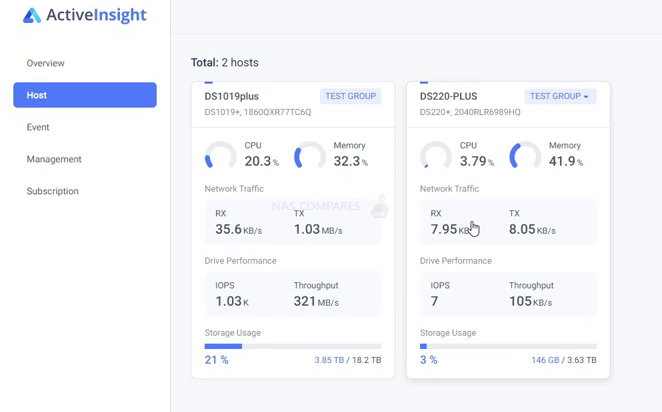
The reports mentioned earlier are highly customizable and along with a lot of customization for the business’ own presentation around the reports, they also allow a lot of bespoke alerts to be covered – either as periodic daily/weekly/monthly reports or ad-hoc alerts based on particular system activity, access and/or health.
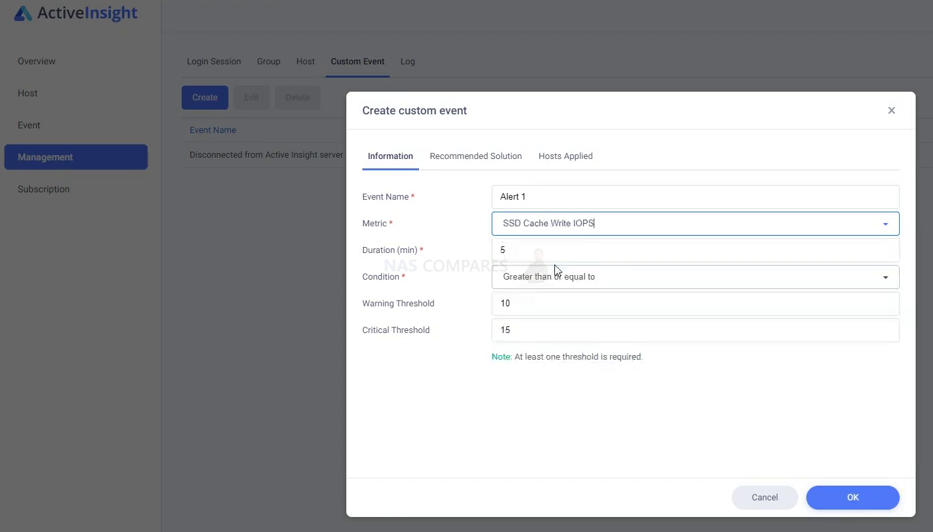
The Active Insight system also allows access via a dedicated mobile application (Android/iOS) which allows you to see practically everything you can see on the browser-based GUI, but also allows all of the security precautions to be in place too – VERY useful for monitoring or implementing changes on the fly in less convenient locations. The view can get a little squished with even a handful of NAS (as you might expect) and even with 4 systems being monitored, the mobile GUI became a tad too limited compared with the Browser access in testing, but still a very useful tool.
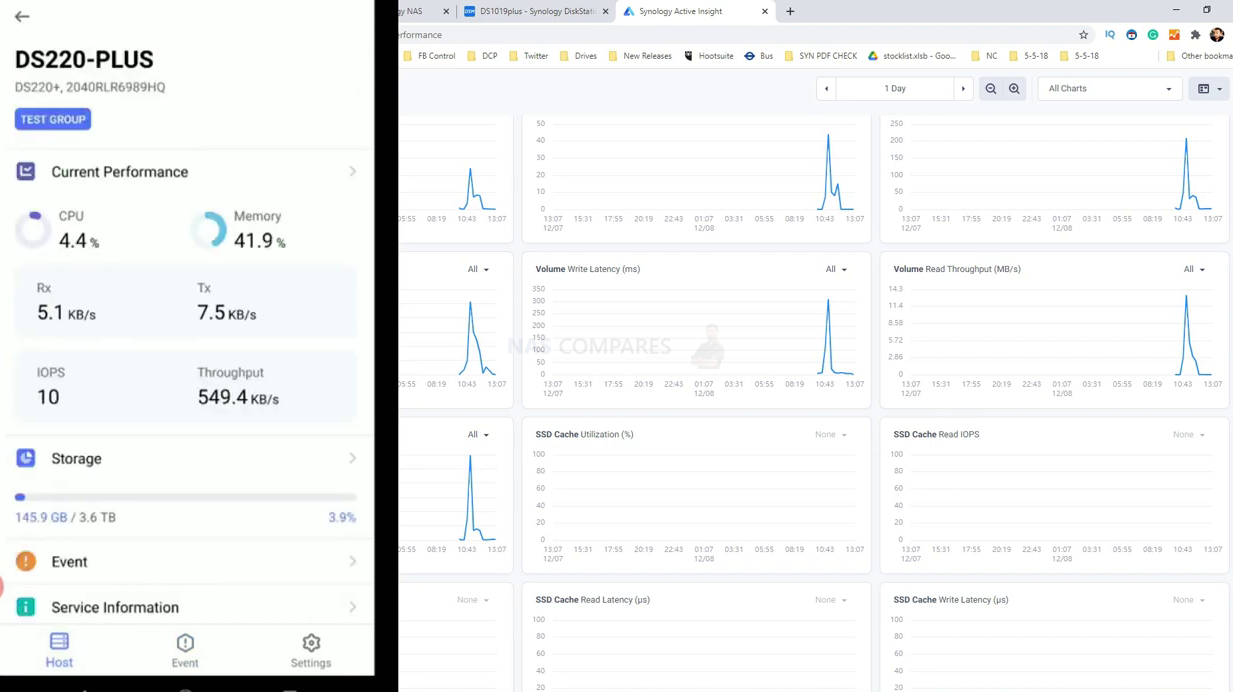
Active insight is a very difficult tool to describe its virtues for without experiencing it or yourself (again, hence why I am surprised by Synology, not including a 1-year subscription or a Free X NAS licence as found in their Surveillance platform with cameras), but the video below of Active Insight testing on desktop and Mobile with DSM 7 from last year will give you a much better idea of what the service can provide business users in 2021/2022.
The Synology CMS application has had a few tweaks and improvements in functionality and design in DSM7 and although it can easily be confused with Active Insight in terms of function, it is very much different in terms of purpose in the end. Active insight is about providing reports and statistical information on one or more Synology NAS Systems and getting them into the hands of those who need them or can action resolutions. Whereas you have to think of Synology CMS as a much more proactive tool for implementing instructions, controlling the NAS server devices, their applications, system updates and actually actioning widespread changes.
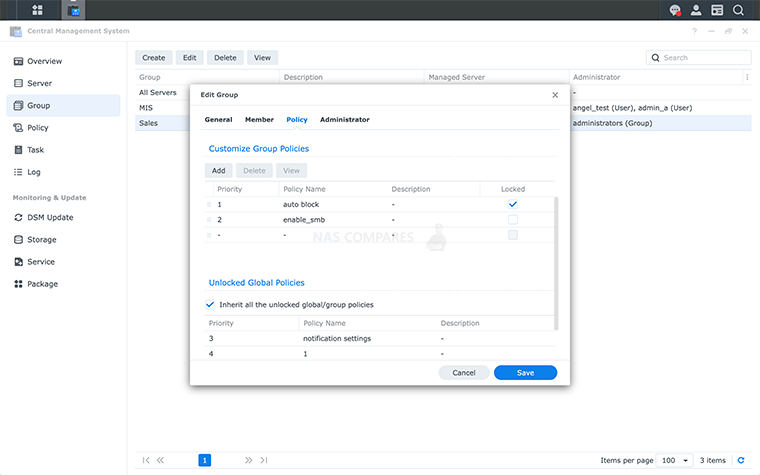
DSM 7.0 brings the same level of control as found in DSM 6.2, but seems to introduce new options, as well as cleaning up the UI a bit. CMS has always been a bit of an intimidating tool, as it allows remote control of updates, changes, reboots and more of numerous devices and right the way down to the app and storage config level too. Although both Active Insight and Synology CMS are powerful business tools, it seems odd that their functionality seems to be separated in this way (though there is some control cross-over), moreover that Active Insight is a paid-for tool and CMS is inclusive within your NAS.
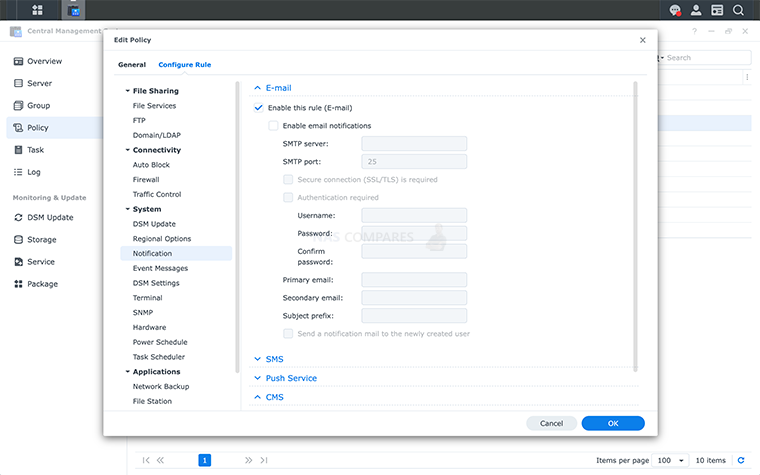
All this said, DSM 7 does a great job of highlighting the viability of a Synology closed software ecosystem, doing a very good job of showing how a multi-site oriented business could be managed by a single user/team, with completely customizable information being available at the frequency that you need. Perhaps it could be said that in DSM 7.0, Synology has shifted focus away from the home and SOHO market and towards bigger targets in SMB, Enterprise and Hyper Scale environments – but this was something we could already see in their latest HDD/SSD releases, so shouldn’t come as a massive surprise really. There is no arguing that DSM7 has ramped up its business support, but so far DSM 6.2>DSM 7.0 has been a little less rewarding on home/Prosumer users. Let’s talk about the last few business killer apps that Synology includes in Diskstation Manager and how/if DSM7 has changed much.
Synology DSM 7 Review – Business Applications
Synology has spent the last few years retooling and ramping up the range of modern business and network storage applications in DSM, clearly making 1st party software and services a HUGE priority. Alot of these upgrades and changes to the key software took place in the last 3 years as DSM 6.2 became established and although in some cases DSM 7.0 has applied a few improvements in the UI of each of them, they remain largely the same in DSM7 as they did to their DSM 6.2 versions. One that has become a big part of the Synology architecture for business is Virtual Machine Manager (VMM) and although little change is apparent, I will highlight though that recent upgrades in VMM in conjunction with Active backup have significant improved how the software can import/migrate existing VMware/Hyper-V environments that are backed up to be mounted within the Synology VMM system.
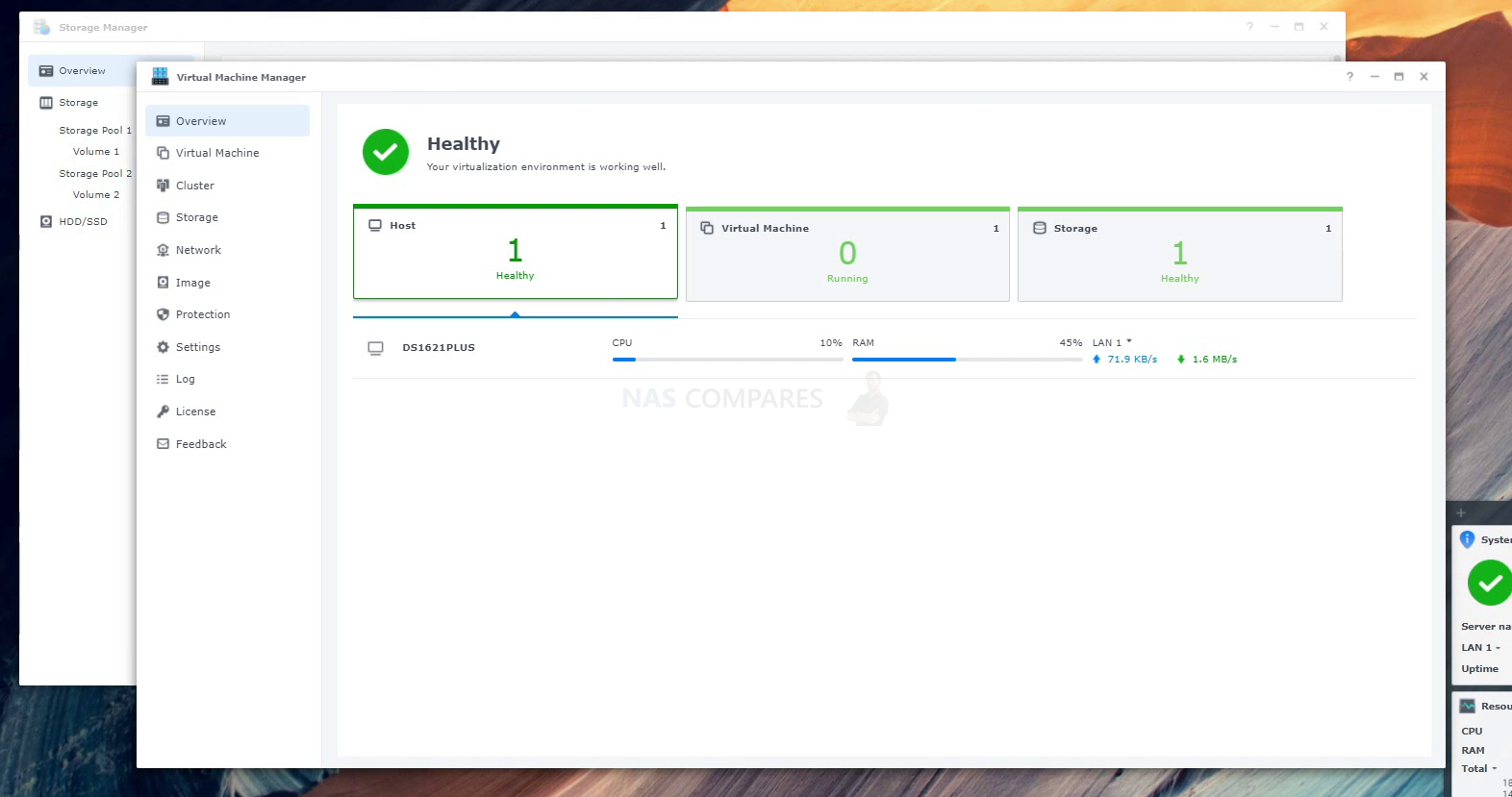
Likewise, the ability to export your existing virtual machine or virtual conversion/image of an existing bare metal machine to the Synology VMM platform is still incredibly straightforward, as seen in my guide to test Windows 11 as a VM on a Synology NAS Video in less than 15mins.
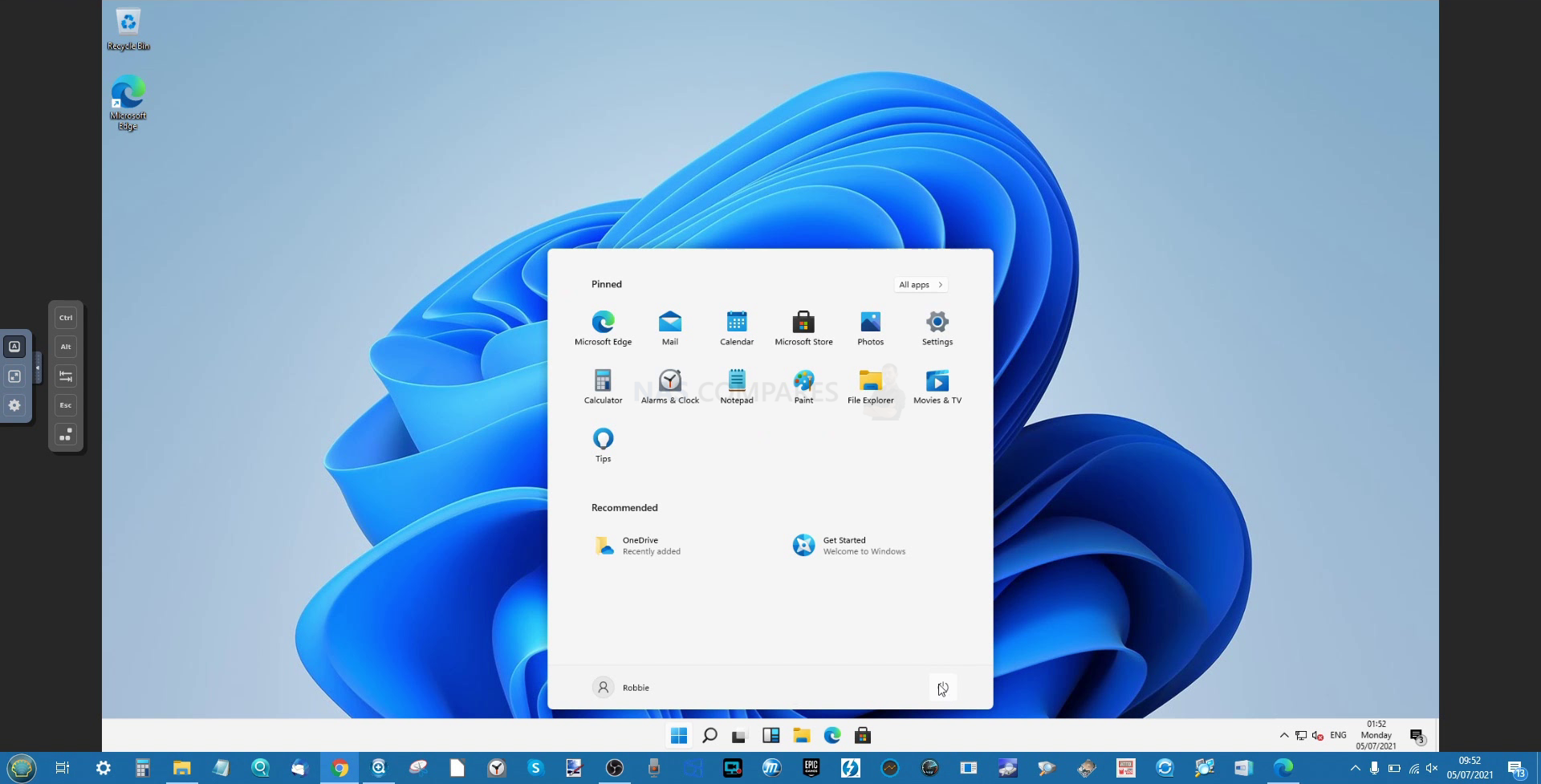
The Surveillance platform on DSM is another area that has received very few visible changes in DSM7, with perhaps the background responsiveness and latency being tweaked in the browser in line with the DSM7 kernel improvements. The Surveillance Station application still runs like an absolute hero in the browser and desktop client application on DSM7 just as it did on DSM 6.2, with full access, configuration and control to all your camera feeds via a Chrome browser as you would like in a local app!
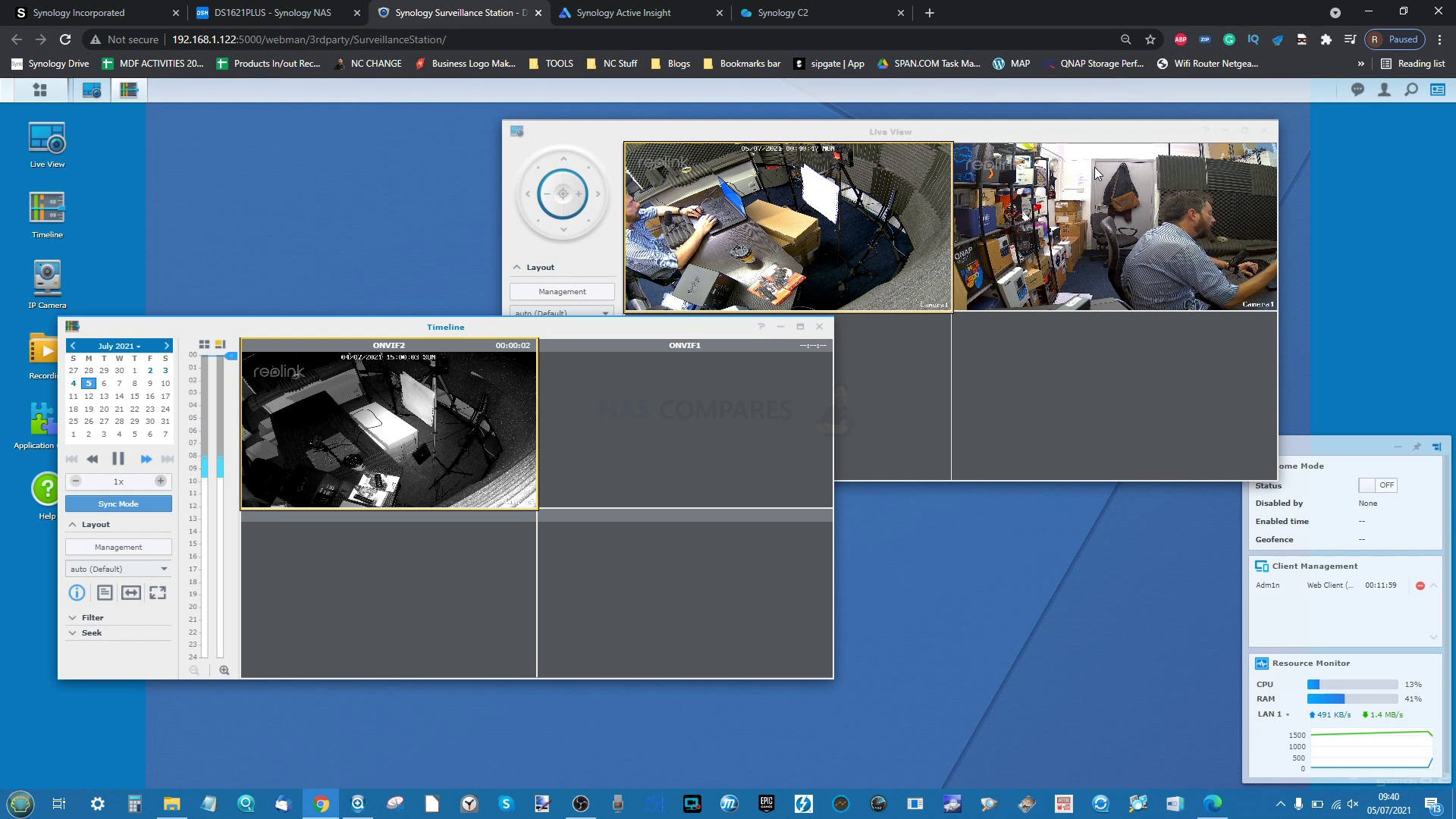
Indeed, even when I tested DSM 7 on a remarkably low powered and low hardware equipped system like the DS120j (2 Core ARM CPU and 512MB memory), Surveillance Station 8.2 ran perfectly well and that was with the more memory-hungry DSM 7 running on it. See how DSM 7 and surveillance, media and storage management ran on this incredibly modest NAS system (along with others) in the videos below
Finally, there is the Synology Collaboration suite of applications (a few already mentioned) that, although not changed a great deal from DSM 6.2>DSM7.0 with the exception of Synology Drive, are still mighty impressive to be included with your NAS drive purchase. These applications include:
Synology Chat – Aimed at businesses, Synology Chat is an IM service that transforms the way users collaborate and communicate.
Synology Drive – Host your own private cloud behind the safety of your NAS with 100% data ownership and no subscription fees.
Synology Calendar – Stay on track, share calendars, and schedule meetings, while ensuring sensitive information remains safely stored on company premises.
Again, although these applications have not received a significant change between DSM 6.2 and DSM 7, it is still worth highlighting that Synology is STILL the only brand out there that provides BOTH the hardware server system AND a full collaboration suite of applications that can rival that of Microsoft Office 365 and Google. Even if you choose to remain with DSM 6.2, you cannot really fault Synology for developing and releasing this range of applications and including them in your NAS software package a no additional cost – I just wish this was extended to other areas of the more recent DSM7 services, as I am convinced it would make their integrations into even low-level NAS network environments more palatable and home users make the switch more readily.
Synology DSM 7 Review – Conclusion
Unsurprisingly I have almost exclusively positive things to say about DSM 7. Throughout the years of development, this upgrade to diskstation manager has maintained a high standard of quality and features at each level and each beta preview stage, with this final product living up to ALMOST all of its promises. There are still a few key features that have yet to arrive, such as drive failure prediction and promise Mac OS support in Synology drive (file pinning, streaming) and support of Mac OS in active-backup, but practically all other promises have been maintained and DSM 7 does the impressive job of almost immediately making you feel that DSM 6.2 is dated -not a small task. Additionally, it is hard to forget that DSM 7.0 is equivalent to an entire operating system and some users are quick to forget that this is included within the cost of your NAS Purchase, so when the hardware warranty of a NAS system passes (2, 3 or 5 years) the software warranty and support continues for years and years after, with DSM 7.0 giving way to DSM 7.1 and onwards. So, it is hard to be critical of software and services that will likely change and improve over time.
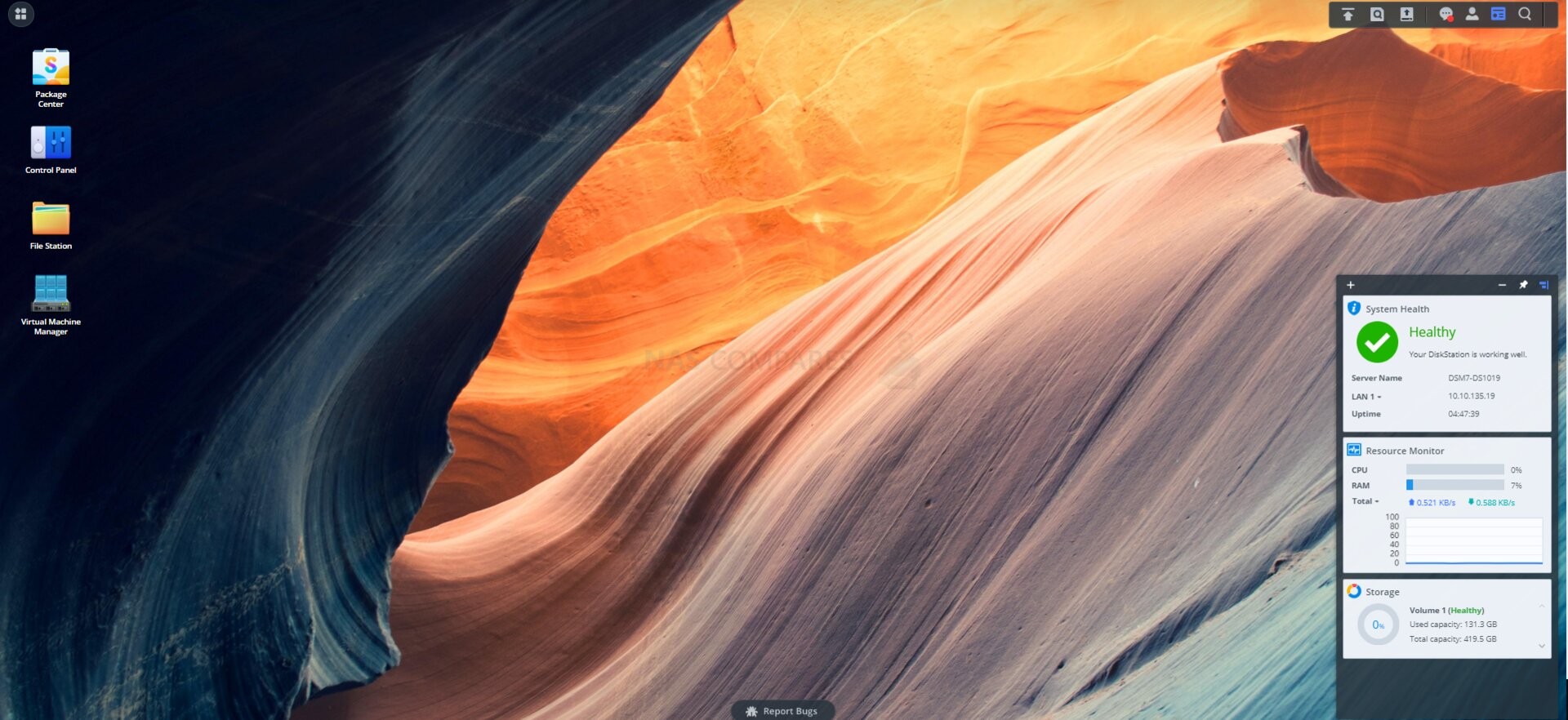
That said, there are things that I think Synology DSM 7 could perhaps improve upon, the steadily more open move by Synology to graduate out of SOHO/SMB NAS and into the Enterprise and HyperScale data center environments has the potential to leave those lesser user tiers getting left behind. This is amplified when several of these new DSM 7 and new-gen services arrive with restricted or paid subscription-based models at the ground level (like HybridShare only supporting their own cloud, Active Insight being a paid subscription service and Synology C2 not having a free tier at a smaller GB bracket). Synology DSM 7.0 is of benefit to ALL users and the vast improvements in responsiveness, design, security and further tweaks to the UX for ALL users cannot be understated – it’s a triumph. Likewise, the storage improvements, inclusive collaboration suite, Surveillance tools, VM manager and integration with 3rd party cloud in most areas is 10/10 for me. The lack of support of USB devices, missing config of Photo Station and the where Synology stand on 3rd party applications in DSM 7.0 still seems a little murky, but it’s still very early into DSM 7.0s life to make sweeping judgements on these. Overall, I like it, DSM 7.0 is almost perfect!
| PROs of DSM 7.0 | CONs of DSM 7.0 |
| Genuinely Impressive Latency
Very Appealing GUI Unbeatable First Party App Support Near Perfect Single EcoSystem Makes DSM 6.2 Look Dated Fast RAID Repair and RAID6 Improvements Surveillance, VMs, Backups and Media Handling all still 10/10 Feels JUST as Secure & Safe as Ever Hyper Backup & Cloud Sync Still Support MANY Clouds Active Insight, Active Backup, C2 & HybridShare = Business Win |
Reduced USB Support Currently
Some 3rd Party Applications have not migrated well Synology Photos Still Lacks some Photo Station Services Hybrid Share ONLY Supports Synology C2 (Paid Sub) Occasional Conflict of DSM 6.2 to DSM 7 Designs at times Synology Drive File Pining & Active Backup Still not Available for Mac |
📧 SUBSCRIBE TO OUR NEWSLETTER 🔔
🔒 Join Inner Circle
Get an alert every time something gets added to this specific article!
This description contains links to Amazon. These links will take you to some of the products mentioned in today's content. As an Amazon Associate, I earn from qualifying purchases. Visit the NASCompares Deal Finder to find the best place to buy this device in your region, based on Service, Support and Reputation - Just Search for your NAS Drive in the Box Below
Need Advice on Data Storage from an Expert?
Finally, for free advice about your setup, just leave a message in the comments below here at NASCompares.com and we will get back to you. Need Help?
Where possible (and where appropriate) please provide as much information about your requirements, as then I can arrange the best answer and solution to your needs. Do not worry about your e-mail address being required, it will NOT be used in a mailing list and will NOT be used in any way other than to respond to your enquiry.
Need Help?
Where possible (and where appropriate) please provide as much information about your requirements, as then I can arrange the best answer and solution to your needs. Do not worry about your e-mail address being required, it will NOT be used in a mailing list and will NOT be used in any way other than to respond to your enquiry.

|
 |


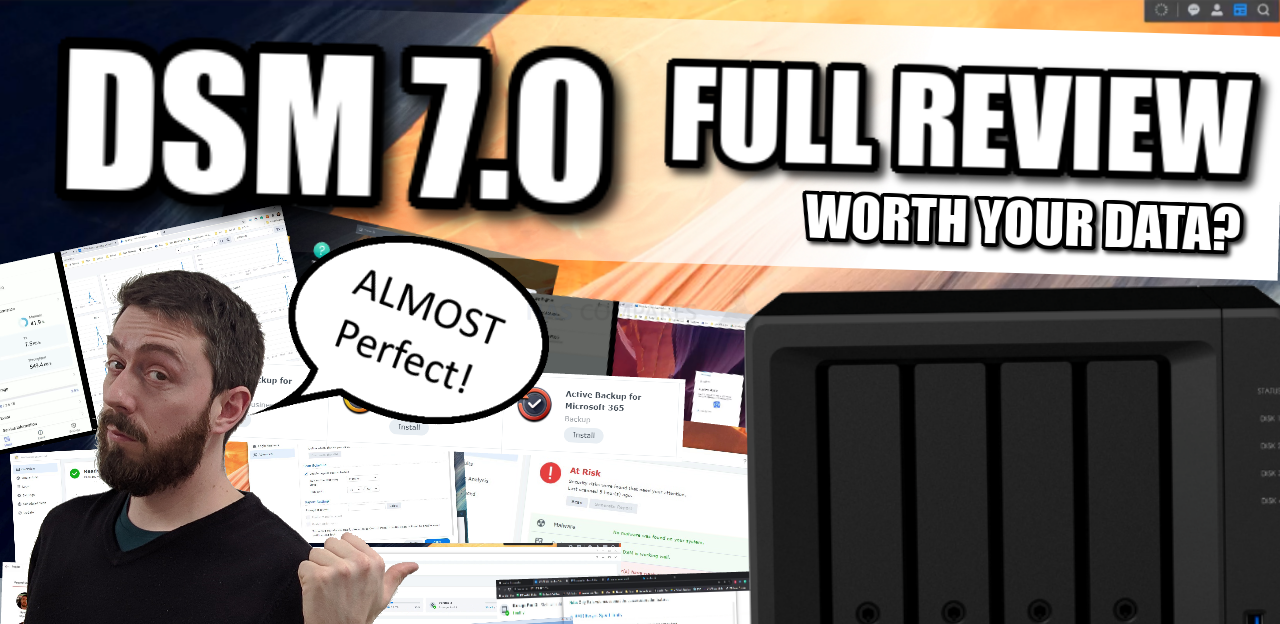

Is this still possible after they locked many methods
REPLY ON YOUTUBE
This video is fake. I can not even log in my 220J NAS, synology scam us with J and 7…. dsm system, Do not buy any J synology , or if just use less than 7 system. DSM 6 works fine.
REPLY ON YOUTUBE
In 2024, I’m running DSM version 7.2 and it runs fine, backing up my huge photo collection.
REPLY ON YOUTUBE
What about clients? plex has app for android, windows, etc.
Can I play synology video, for example, on my LG tv?
REPLY ON YOUTUBE
Why do ppl even wanna try this on synology? Oh, assign 4gb ram to win11? Why bother
REPLY ON YOUTUBE
I wanted to make sure I had EVERY Blu ray & DVD movie for my FINAL COLLECTION before putting my DS 1817 into operation. I have my Iron Wolf HDD Drives and my WD Red Plus HDD drives also. Just have about 18 more movies before starting this process, I tried to inform everyone that this was the best alternative than streaming on pay movie platforms. Because this way if the Internet goes out or the GRID goes out and generators or renewable energy is the only way YOU STILL HAVE YOUR MOVIES in a NETFLIX FORMAT. *Now as the world gets crazier, I can still keep a NORMAL ROUTINE. THANKS NAS COMPARES for your thorough analysis and expertise.
REPLY ON YOUTUBE
Thanks for this great review!
REPLY ON YOUTUBE
What about the audio in this windows 11?
REPLY ON YOUTUBE
I did everything the same but I get the error: “This PC can’t run Windows 11” message and I can;’t continue
REPLY ON YOUTUBE
I’m dumb 🙂 I’m playing around with my nas to see what it can do and what I can do to and with it…what can I use win11 on my nas for?
REPLY ON YOUTUBE
should also test plex… 1080p (HD) and 2160p (4k) one of the main reasons people buy them also
REPLY ON YOUTUBE
Cheese ????
REPLY ON YOUTUBE
I encounter this error when connecting to the wm: “guest has not initialized the display (yet)”. Anyone can help?
REPLY ON YOUTUBE
Can Tiny11 be setup as a VM on a Synology? If so, could you make a tutorial? Thanks
REPLY ON YOUTUBE
Is there a way to create Windows VM on a NVM ssd cache? Or on USB 3.0 Nvm SSD 128GB Drive?
REPLY ON YOUTUBE
Thanks for your Vs !! You have resolved a different problem I was having with Plex on Synology using Nvidia Shield Pro; not being able to have separate profiles. I’ll shortly achieve this by using Plex as one “profile” and VS for the other “profile”. Maybe even get the Firestick as for VideoStation and keep Plex Player on the Nvidia, unplug the Firestick too restrict access..
Cheers! Thanks for your awesome channel!
Looking forward to DSM 7.2 and seeing how to install DSM and Plex Media Server on Synology with 2.5″ SSDs as Volume 1 and then Volume 2 a seperate RAID array of HDDs (and maybe some M.2 filled slots for SSD cache at the same time?!????????)
REPLY ON YOUTUBE
For example, when the initial setup only uses a 6TB hard disk with SHR RAID type. Then in the future we will add another 6TB hard drive, do we have to set RAID settings again when adding a hard drive or will it automatically become SHR and be allocated for protection?
I have DS420+ with DSM 7.1
REPLY ON YOUTUBE
*Update, Synology DSM has been updated to DSM 7.1. So, check out my MASSIVE Synology DSM 7.1 Software Review HERE – https://youtu.be/SqFa0WyxGJc *
REPLY ON YOUTUBE
I use plex for a couple of years and i’m frustrated because i have constant HDD activity on it. I stoped all the logging, background activity services and still, it has activity. If i stop plex, the HDDs stop,
REPLY ON YOUTUBE
how to change the default source folder for synology photos?
REPLY ON YOUTUBE
I have found that if you name your video media with the {imdb-tt…..} tag (for Plex) and the {tmdb-…} tag (for VS), both seem to perform equally well. What Plex does that VS doesn’t do, is allow for tagging auxiliary media, like -scene, -behindthescenes, etc. VS will treat those as distinct files, and there’s usually no good poster art for those.
REPLY ON YOUTUBE
worst upgrade I have ever done. All DSM 7 has done is regress features and disabled the ability for the user to do anything to upgrade performance. Can’t even use a 2.5 gb ethernet dongle anymore. A pox on Synology! If you want to do anything with the usb ports, stick with 6.2.4 and don’t upgrade – Synology has pulled all copies of DSM 6 from their servers for the 920+ , so remember to keep those upgrade files, don’t delete them after upgrading if you do it.
REPLY ON YOUTUBE
windows vms are slow and dont know how to upgrade the video driver, any help
REPLY ON YOUTUBE
I’ve used Video Station for years, both on an older (413j) model and a newer (920+) model. Generally I love it for the media organization and auto-downloading of metadata. It can generally handle playing of all formats in-app and when streaming to the DSvideo app on a phone.
However, VS seems to be frustratingly hobbled when streaming video to Chromecast ultra. It doesn’t seem to support transcoding x265 to a format the CCu understands at all, and there are some audio formats that aren’t supoprted as well – DTS among them. Whether this is a limitation of VS or of the CCu, I’ve never been able to get a straight answer for – both devices *should* support these formats, but VS doesn’t seem to .
Anyone have any suggestions (other than “use Plex”) for this setup?
REPLY ON YOUTUBE
“it’s still early doors”
REPLY ON YOUTUBE
Sad to say it seems to no longer work as at least on my DS920+ it says it does not meet the requirements to run windows-11 I am sure the pre-retail versions did not have strict requirements which is why it worked for you,. Lucky for me I still had an old windows10 ISO and used that instead.
REPLY ON YOUTUBE
FASTASTIC video as always!
If you allow me one question please
In the min 10:54 when you talked about backup the main NAS to a second NAS
using Hyperbackup, you talked about doing it in the morning when the NAS is less use
If i run the backup let say at 3am, my pc will be “sleeping”. Will Hyperbackup work even though the pc is “sleeping”?
Thanks in advance
Have a Productive and Healthy Day!
REPLY ON YOUTUBE
Can you prepare video on windows 11lite on Synology, the version that you show us very slos
REPLY ON YOUTUBE
The only issue is Synology forces you to use the pre designater folder… Most of us have share folders with different names. In my case I have a folder for videos and other for photos. I cant add them on the Synology Photos.
REPLY ON YOUTUBE
Never… ever… apologize for the seagulls !!!
REPLY ON YOUTUBE
For music that you could play, No Copyright Sound (or is it Songs?) or NCS shouldn’t give you any trouble with YouTube. Along the same lines, The Blender foundation or someone releases “movies” under similar license terms. Big Buck Bunny is a pretty good example of that.
REPLY ON YOUTUBE
I FINALLY HAVE all the movies I want for my ENTIRE COLLECTION for Videostation Synology. *SO IM DONE WITH THIS!!!!
REPLY ON YOUTUBE
I am thinking about getting a DS220+ for a dedicated home security system. I would have 3-4 4K cameras. I would upgrade the memory to 6 GB since I have a spare 4 GB. Would the DS220+ be sufficient for this task? I already have a DS-918+ for other NAS tasks.
REPLY ON YOUTUBE
I am using Video Station with my Chromecast with Google TV. Many of my videos are encoded as AVI. MP4s and others work fine. I have used VLC to convert a few AVI videos to MP4 but I have a lot of them. My preference would be to have Chromecast recognize VLC as my default video player. I do prefer Video Station. It works fine on all my other devices. Has anyone with the Chromecast solved this?
REPLY ON YOUTUBE
Hi there! Great video!! One question… how fast is windows 11 on sinology vmm when compared with windows 10 vmm? Thanks again.
REPLY ON YOUTUBE
I cannot beleive that there is NO WAY to sync any folder and file type from android device to synology nas… that drives me nuts… it’s either super complicated third party app to configure or the only syncing possible is with ds file that does ONLY pictures or synology photo crap app… I just want to sync ANY folder and their files in it (like download, ringtones and so on)… why the hell can’t synology do such thing ??? ds cloud does NOT permit to sync android folder to nas, it only sync the cloud that is on the nas to the android device, I want the other way around, there is no way to sync android ANY type of android files to nas.. urgh…
REPLY ON YOUTUBE
PLEX for my Synology 920+ was a big headache, compared to my old computer hard drive setup.
REPLY ON YOUTUBE
My synology is messing up my local network and I can’t figure out why. Internet drops for a few seconds every few min on all connected network devices. If I disconnect the NAS from the network, it seems to work just fine.
REPLY ON YOUTUBE
Login Speed – seemed easier with entering user name and password on the same dialogue to only hit enter once, especially when credentials are stored in the browser. Perhaps they changed it for increased security, prefer the old way.
REPLY ON YOUTUBE
Hello! I let me share my experience/questions both at the same time. I have a DS1618+ and lots of movies on it and a couple of smart TVs. Most of the times I am able to browse the DS folders from the TV directly or just stream on the TV via the DS app on my iPhone/iPad. Problem however is with some mkv or mp4s that have DTS audio. It just won’t stream at all or won’t have a sound. So I bought Apple TV thinking this £170 worth of gadget will sort it out for me (with the annoyance of the home screen offering me things/media I bloody don’t want). However much to my disappointment the Apple TV is just as useless. Despite downloading the DS app on it and browsing the videos on the NAS it failed to play most of the movies, even after fiddling with all settings in the DS itself and Apple TV too. So I am returning this useless gadget.
Back to the problem. If I play movies from the DS on my mobile/iPad I can use the VLC and although it’s an average software, it does work though! But that’s a solution only for the mobile devices.
I had Plex too. But for gods sake. Adding/sorting libraries was freeking pain in the a**! I was astonished how annoying and difficult to use the Plex is, absolutely ridiculous. So I stopped the subscription and gave it the finger. I can’t understand what’s the rave about this stupid service.
Back to the question. Has anyone found an easy and convenient way to stream movies (including DTS formats) on the TV via/from your DS whether streaming it with the mobile or with the help of something like android box or whatever.
Much appreciated in advance.
REPLY ON YOUTUBE
Every time I try this, I am met with the message that this PC cant run Windows 11, on a DS920+, any advice?
REPLY ON YOUTUBE
Great help for a first time user. Quick Q: I’m able to manually add an SRT subtitle track for a movie but this does not equate when I mirror it to my television, nor when I access the movie through the DS Video app on a Firestick. Is there a work around that you know of?
REPLY ON YOUTUBE
I used both..plex is just way better
REPLY ON YOUTUBE
HEHEEH, Yes, We absolutely Like chess.
REPLY ON YOUTUBE
one issue I have is when uploading video or photos it becomes unusable. indexing takes forever.
REPLY ON YOUTUBE
quick question. Can you use both Video Station and Plex with the same library locations at same time?
REPLY ON YOUTUBE
When I open Snapshot Replication app on DS7, it warns me that my volume is recording ‘last file access time’, and this may affect snapshot performance. It tells me I can disable this by going into Storage Manager, but that setting is nowhere to be seen. Any ideas?
REPLY ON YOUTUBE
I’m about to buy my first NAS, this very one, ds220+, not even for myself, it’s actually for my dad and man!… Amazon feedbacks are exilarating! The amount of people putting you off buying because of their shitty 1 to 2 stars conplains about noise, can’t navigate the OS, or straight out malfunction from factory is enormous for a product and brand that I’m convinced it’s really good. One thing though, a customer did complain about his unit becomming unusable after DSM 7 upgrade and since those 2 gigs of RAM sound really tiny for 2021 I did worry for a moment there and many are complaining also about Synology support being slow and useless. Can anyone confirm?
REPLY ON YOUTUBE
If they used Ryzen V1807B there would be hardware encoding/decoding and even HDMI port (if you need)
REPLY ON YOUTUBE
My DS200j was updated to DSM 7 and it sucks. Transfer speed dropped from 110ΜΒ/s to 10MB/s and it is soooo slow. I updated based on this video and now my NAS is useless…
REPLY ON YOUTUBE
8:40 – I wish we could find the person responsible for using a Funnel for the filter icon and make them walk the plank. Funnels are not filters.
But its too late now. The damage is done. People associate the funnel image with the filter action in software just like they associate the piece of paper with a folded corner for “new file”.
REPLY ON YOUTUBE
Does Video Station create a default folder on NAS called “video”? Is that where yo upload your movies etc? And does it automatically sort movies from tv etc?
REPLY ON YOUTUBE
So I am really confused here. I use my 220j almost entirely for streaming videos. If that is the only thing it is doing is DSM 7.0 a mistake or not? Experiences SEEM to go both ways but no opinions from people that have updated to 7.0 are straight in whether it is ok.
REPLY ON YOUTUBE
Does Synology Photos offer face recognition on DSM 7.0 running on DS220J?
REPLY ON YOUTUBE
I was planning on setting up a NAS early 2022 and had chosen the 920+ but I’m hoping there’s an upgraded replacement but can’t seem to find any reliable product news. Can anyone point me in the right direction?
REPLY ON YOUTUBE
How to install the Audio output device ON a VM?
REPLY ON YOUTUBE
After updating my ds220j to 7 its so slow , could be due to photos indexing?
should I backup my phone photos again or move photos ( that already been backed up by ds file app ) to the folder that used by photos app?
Thanks
REPLY ON YOUTUBE
The missing “For you” from moments sorely missed – it was a great AI system for finding potential duplicate (or near duplicate) photos that just doesn’t work as well as the storage manager reports that only really find exact duplicate pictures.
REPLY ON YOUTUBE
How to install the Audio output device ON a VM?
REPLY ON YOUTUBE
Run out of memory ……
REPLY ON YOUTUBE
as 220j user … the only thing hungry on performance is rending video in moment …
REPLY ON YOUTUBE
Thanks for this great comparison!
REPLY ON YOUTUBE
1.Log center cant be modified or set to exclude users or certain things you dont want logged.
2.It is not compatible with DScloud anymore so you cant sync to mobile like you can do on DSM6 with the DSCloud app from Synology but you can use the Synology Package Center to download Resilio Sync or Good Sync but you have to pay a monthly/yearly fee for every user.
Unlike Qnap when you buy your hardware, you arent forced to pay for syncing from and to your own hardware.
With that said there is still a solution using Webdav to-way Nas-pc with Raidrive but you have to pay for software for Pro features.
Mobile sync: Use Foldersync to-way Mobile-Nas, but you have to pay for software for Pro features.
So far as i am aware of limitations using Synology DSM7 when it comes to syncing —> If you want Pro features or you want to use your Nas without reaching out to third-part software without paying extra fees it is recommended to switch to other Nas brands for me i feel Qnap has been working using 30 users for Laptop/Pc/Mac/Android/Iphone all Apps/Software working perfect Pro features without paying extra fee´s or forced to use third-part tools total control for Log center, File-Folder, Photo, Video, Virtualization, Web-sites and so much more.
Other annoying difference i had with Synology i had was this—> i had to make a ticket to find out i cant use Synology Mobile App DS Cloud or that one cant choose what Synology Package-Log Center loggs, it wont let you choose to include, exclude or to delete certain logg if you press Clear button on the loggs that are in “Files downloaded” it deletes all, if you clear “user logins” it deletes all that and you cant revert the deletion.
REPLY ON YOUTUBE
It should be pointed out that the ability to edit metadata is limited in the mobile versions. I was unable to change the date / time of photos on the iOS app, but it works in the web browser version.
REPLY ON YOUTUBE
qnaps video station equal doesn’t seem as good as this by a long shot, this alone makes me wish I got synology ????
REPLY ON YOUTUBE
Totally agree with your view on Photo Station. I’m glad you covered this as your feedback might get recognised. I don’t want to upgrade until Photos is comparable to what Photo Station had/has to offer.
REPLY ON YOUTUBE
almost perfection?
Audio Station is totally broken, playback is being cut off,
Media indexing fails to scan more than 50% files,
translations in DSM are not complete, some even have nonsense,
I have no idea what Synology have been doing all the time releasing such buggy software
REPLY ON YOUTUBE
918+ here with upgraded 16gb ram. Am I going to have issue if I upgrade to 7?
REPLY ON YOUTUBE
How do I change dsm7 login page to have username and password on same page?
REPLY ON YOUTUBE
Just install DSM7 on my synology 1819+
REPLY ON YOUTUBE
No star rating system in new Photos, bit of a deal breaker for me.
REPLY ON YOUTUBE
Hi there, how does PLEX do with DSM 7.0 on the DS220J?
REPLY ON YOUTUBE
DTS doesn’t work, so it’s useless. ‘Cause DTS is standard. … -U MUST USE PLEX… -noch other way. (as of 02.08.2021)
REPLY ON YOUTUBE
missing peoples option in photos, DSM 7
REPLY ON YOUTUBE
Awesome. I can finally stop paying apple for extra iCloud storage. Have just moved all my photos on my iPhone to synology photos. Awesome app.
REPLY ON YOUTUBE
Gouda explanation, very clear and easy to follow, was a bit Cheesy but I’ll take it because there’s stiltonnes of things I have to learn, but with this info my backups will be as robust as a Roquefort ???????? thanks as always
REPLY ON YOUTUBE
The new “Synology Photo” is a total waste. On google, simply seach “synology photo metadata lost” and you will find lot of people complain about they all lost their ability to search. If you were using Photo Station, and spend days/month tag everything, after upgrade to DSM 7.. you won’t be able to find your thing. Approx 10% will be there.. all other will be a simple picture. Probably the worse update they made now for the picture management. You will need to install external software to your computer, and re-scan the database. As in PhotoStation, metadata are located in the picture, if you copy your database to another Synology NAS (DSM6.x) and activate Photo Station, everything will work agait, as Photostation can work with that data, like most other Windows sofware that do picture management… not the case with DSM7
REPLY ON YOUTUBE
I’ve been using DSM 7.0 for about two weeks now on DS220J, and it somehow feels faster and snappier than DSM 6.0
REPLY ON YOUTUBE
Useful but a bit of a ramble with Robby. My time notes:
https://youtu.be/xZrjPF4nmRc?t=674
11:14 User Interface
12:00 Help Center
12:35 Control Panel
14:03 Security
15:27 Collaboration Suite
15:45 Synology Drive
17:18 Multimedia Apps
18:47 Plex and 3rd party app issues
19:47 DSM 7 background package integration improvements
20:25 HyperBackup, USB copy
21:24 Cloud Synchronization
22:27 Business Applications
23:30 Storage Manager
25:15 Fast Raid Repair
26:35 RAID 6 speedup
27:19 Bench testing, storage performance, UI improvements
29:00 Surveillance Station
30:04 Virtual Machine Manager
32:40 USB changes on DSM7
34:08 Security and UI
34:40 Resource Monitor and UI
35:00 Storage Analyzer
36:55 Recommendations
REPLY ON YOUTUBE
I’ve installed it as a VM on my DS1821+ and I’m completely disappointed with the new photos app. Maybe I’m old fashioned idk but the way timeline view is implemented it doesn’t allow you to look at a timeline on an album level anymore like you could do in photostation. You have to choose between album view or timeline view. I like to look at my photos different ways and this makes the app kind of unusable for me. Additionally I would like them to shows tags on the timeline view when you’re inside an album that has multiple albums underneath it but no photos in it directly. I’ve reached out to them but very little hope of it getting done in my opinion. I’m not upgrading until photos is useable as photostation is no longer supported on dsm7. Additionally I had a lot of indexing / conversion issues on my VM with my photos directory. Not sure if that’s just a VM issue or not
REPLY ON YOUTUBE
you talk way too much unnecessarily !!
REPLY ON YOUTUBE
The audio is of sync with the video
REPLY ON YOUTUBE
Since when Synology uses china domains ? Isn’t it Taiwanese company ?
REPLY ON YOUTUBE
How to downgrade back to 6.2?
REPLY ON YOUTUBE
Hi. Is it safe and or good for my Synology 920+ to be shut down during the night and sometimes for 30 days at a time while away? Many thanks for your great videos.
REPLY ON YOUTUBE
I upgraded both my DS 218J and my brand new DS920+ to DSM 7.0 and liking it a lot! No real problems. Moments with my Photos lost its tags during the transition to Synology Photos. I have to redo them but that’s ok. Everything else is great. I agree with this review.
REPLY ON YOUTUBE
so is there any reason for me to wait for the DSM update to come through automatically on my DS1520+ or should I just manually update now? Is it likely that more changes will be made to it before the automatic update comes through?
REPLY ON YOUTUBE
Boomer taskbar, jam packed .. just needs a few AoL or Geocities taskbars floating on the desktop to finish the effect.
REPLY ON YOUTUBE
My NAS is very messy because I had no time to sort out my folders before backing up. How can I search through my whole NAS for pictures and add them in Synology Photos? Than I can delete what I want through the mobile app when i’m chilling somewhere.
REPLY ON YOUTUBE
Does its handle raw photos from the latest iPhones? Very frustrating that they didn’t have this working as the phones almost been out for a year! I am using Photo Station.
REPLY ON YOUTUBE
No Java= no jdownloader????????
REPLY ON YOUTUBE
Does DSM 7 introduce any issues with access via the NFS protocol? I use my DS420j strictly as a file server in a Linux environment and do not really care about photo station, music station, etc. Quick, reliable access via NFS is my main concern. Thank you for your fine videos.
REPLY ON YOUTUBE
Photos all seemed to work once I requested a re-indexing. However, photo sharing is completely broken. Even if you request that anyone can view with a URL, Synology NAS still requests a username and password. Sigh…………………
REPLY ON YOUTUBE
I notice the absence of Amazon S3 on the cloud service for HyperBackup… Is it still possible to backup to Amazon S3 Glacier storage in DSM7? Or they removed it not to compete with their own C2 solution?
REPLY ON YOUTUBE
Thanks for your valuable videos. I missed the loss of DS Cloud, so syncing became a problem. I started using Syncthing after upgrading to DSM7. I also have a problem with Synology Drive from my laptop on a company network, while using Express VPN. It keeps trying to connect to the server. When I switch off the VPN it works fine. Maybe I will switch to Syncthing on this Windows machine as well. For me this is a key function for a NAS so I didn’t expect it to work less good. But all and all it’s a big improvement.
REPLY ON YOUTUBE
For anyone has done the upgrade, how long did it take please ?
REPLY ON YOUTUBE
Great video, thank you!
REPLY ON YOUTUBE
No mention of the issues with third party packages that worked fine in 6.2.4 but no longer work in DSM 7, it might be almost perfect IF you only use Synology apps.
REPLY ON YOUTUBE
Not upgrading until they add support for android folder backup/syncing!
REPLY ON YOUTUBE
Hello, I am sure that it will surely be for reasons of not extending the video too much, but your way of showing and explaining the news and characteristics of this new DSN are not very clear, at least for me you are going too fast and a bit messy. I’m not saying it in a bad way but I think you could do it in a more calm and neat way. Thank you very much anyway.
REPLY ON YOUTUBE
DSM 7, adding support for Google Shared drives via Cloudsync is a Big + for me
REPLY ON YOUTUBE
No one talks about the fact that facial recognition is removed on those J devices.
It was there on moments.
Synology photos is not such a big upgrade compared to moments.
I have seen many reviews but no one seems to mention facial recognition
WHY?
REPLY ON YOUTUBE
I use a KDLinks media stream box to watch movies and videos I store on my Synology NAS DS918+. Does DSM 7.0 support the ability for the stream box to sign into the NAS and stream the files?
REPLY ON YOUTUBE
i don’t like in the Download station the “downloading” word is blue and no longer green
REPLY ON YOUTUBE
This man is clicking faster than his shadow ????
REPLY ON YOUTUBE
20:53 I ran into the exact issue you have 2 days ago on DSM6.2.4. I opened a support ticket that is still open, however I suspect it’s a browser based issue. Try opening in a different browser and see if you can view all of the back up options in that. It’s a Munster to me how this happened as I even cleared my browser cache and it persisted in Firefox. When I opened in safari it was “fixed}
REPLY ON YOUTUBE
Who knew FooOOZ is the correct pronunciation of FooToes. Just kidding ????
REPLY ON YOUTUBE
Great video – in general the audio is a bid low on your videos, would it be possible to turn it up a notch? Thanks 🙂
REPLY ON YOUTUBE
Show idea, upgrading synology hardware. Example, use a ds213 case and change the motherboard to a newer model including modifying the case for USB ports if needed.
REPLY ON YOUTUBE
Your shows are good, however, can you please make them shorter/succinct. Perhaps add text boxes on the screen so we can see that as you move on. Again, you do a fantastic job ???? thanks for your hard work.
REPLY ON YOUTUBE
Photos was over-promised, and under-delivered…. Mostly hype
REPLY ON YOUTUBE
Plex may have not pulled the metadata, but unlike Video station you can manually match metadata to a file. New to Video Station, but there is no apparent way to search for or fix unmatched movie/TV Show files, like there is in Plex. Plus the only “Live TV” it seems to allow is online streaming services. Plex automatically picked up, scanned channels, and was ready to go with my HDHomeRun tuner. Video Station is still “Indexing” everything I added as “Others”. Can’t even see the files listed yet.
Update: Found how to match metadata: Click on 3 dots bottom right/Click “Search Internet”/ Then “Search”. The rest should be obvious I think. But I really don’t like the multiple pages. Plex puts them all on one (Long if need be) page so you just have to keep scrolling down.
2nd Update: The only 4k I have here is DJI drone video, and it don’t like it at all. It’ll play 10 or 20 seconds and then just freeze. Whereas Plex may pause once in a while, but most times it plays it fine. Update B: It don’t like 1080p drone video either… whereas once again, Plex has had zero problems with.
Also, I like the “Click on screen” play/pause thing, which Plex has, and apparently YS does not.
REPLY ON YOUTUBE
One thing I’d love is for larger NAS to support mounting volume from older smaller NAS.
For instance, I had an old DS411j that failed on me, one of the drive failed but the NAS was full, so now I can’t even start it up. I just wish I could buy some of the 12 slots new NAS and then mount my 4 old drive into the new system and then just transfer data and format the old drives to add them to the new volume. I asked Synology if we can do that, their answer: nope, unless you build a Linux computer and mount drives on Linux and transfer your data. If I need to build a Linux computer, I’d better off just to use FreeNAS and never have to deal with Synology DSM…
REPLY ON YOUTUBE
Microsoft Edge is base on Chromium, so any issues you have with Chrome will most likely happen in Edge as well. You need to test on browses like Firefox that are not base on Chromium.
I use Firefox and only have one M.2 slot filled and the 4 HDDs bays are full. Testing what I could zooming out made the empty M.2 disappear. It did not make the icon show under the other one as shown by you..
REPLY ON YOUTUBE
What’s the later on PLEX… yesterday I was advice to use Docker as PLEX is not installing correctly?
REPLY ON YOUTUBE
still no on-demand sync for Synology Drive w/ Mac OS in DSM7. Synology really dropped the ball for Mac support. DSM7 not worth the hassle.
REPLY ON YOUTUBE
Is it possible how do a clean install Synology dsm 7 on my new Synology ds1520Plus?
REPLY ON YOUTUBE
I would have liked more analytics inside VPN Server eg bandwidth consumption from each user (up/down) ????????♂️
REPLY ON YOUTUBE
i have a test DS119j and upgraded it to DSM 7 and it’s very slow. Tested 4gb of photo’s and the database is going on for days.
Going to upgrade my DS1821+ now. Hope 10GB will still work.
REPLY ON YOUTUBE
For the past week, Universal Search has been HOARDING CPU and RAM!
Indexing just goes on and on and on, non stop!
I can’t find a workaround!
Disabling Universal Search in DSM 7, disables Synology Drive and Synology Office
Instructions for this problem, found on forums, are all for DSM 6 and DON’T work on DSM 7
This is pathetic!
REPLY ON YOUTUBE
For me it doesn’t matter as much if the new apps arent quite as good as the old ones yet as long as they have been written on a newer platform that easier to add missing and new features later rather than an app that was based on ds 4. Apple’s old website went down before a launch not to increase excitement but because it was old and rubbish and had to be .
REPLY ON YOUTUBE
2fa should be incorporated Into DS finder having said that authy is miles better as you can transfer it to other devices
REPLY ON YOUTUBE
Did you do a manual update or did DSM 7.0 show as an update automatically? It has not shown up on my RS1221+ or DS216+II in Canada yet…
REPLY ON YOUTUBE
Still I have hibernation issue and I opened a ticket with Synology support. After analyzing the debug logs, they came back with SMB and VMM are the cause of periodic waking up of HDD’s. But still I couldn’t find an answer from support that why this periodic waking up which exactly happens each hour related to VMM and SMB, assuming no laptops connected to NAS in the test period and no VM was running. Will update in case support answers me.
REPLY ON YOUTUBE
Thanks for this, just what i was looking for!
REPLY ON YOUTUBE
I’ve been waiting for this video!
Do you know if DSM 7 affects the transfer speed over the 10G network? I now on the old DSM get up to 8.9 Gbs and was wondering if the new DSM would speed it up any?
Also if adding additional drives is any faster? For example going from 6 to 8 drives, will it take days again or hours as promised in their marketing videos?
REPLY ON YOUTUBE
Sorry but I’m totally inexperienced about that.
Why should I want to install a Windows VM on my Synology NAS?
REPLY ON YOUTUBE
@NASCompares Hi bro, I didn’t see in video the TPM mandatory option for Win 11. Does this mean installation is possible without TPM module?
REPLY ON YOUTUBE
We use mostly qnap’s, but do have one or two synology’s. We have migrated some of our Windows file server data storage requirements to a few of the qnap’s due to running out of storage on the windows servers. Do you find the synology or qnap better as a file server replacement? I am integrating AD and the qnap’s seem to be handling it fine, but I must admit I’m losing sleep. It’s odd to move away from the Windows servers, but the NAS solution is just easy and I can update / reboot domain controllers and servers without affecting data access. Would love to hear your thoughts and see a video on setting them up as file servers.
REPLY ON YOUTUBE
First? And thanks this is something I need to do
REPLY ON YOUTUBE
Can you test it on a nas thats not in the supported list like my rs812+ 🙁
REPLY ON YOUTUBE
Dude – you got windows updates pending. 😉
REPLY ON YOUTUBE
Please help me: Tried loading DSM 7 on my DS920+ currently on ver. DSM 6.2 to just test use it on VMM. While trying to load the correct file: “DSM_DS920+_41890.pat” I got this error message: An error occurred while creating the (DSM) image. [DS920Plus – VM storage 1] The installation file is incompatible (?!) Please make sure you have selected the correct file to upload.
REPLY ON YOUTUBE
excellent! thank you
REPLY ON YOUTUBE
Wen a review of full version DSM 7.0 and all the standard application and APPs?!
REPLY ON YOUTUBE
Some of packages like Plex, miniDLNA and Transmission fail to run on DSM 7.0
REPLY ON YOUTUBE
” The camera on the right is ever so slightly delayed”…”maybe 20-25 seconds”. 😀
REPLY ON YOUTUBE
Great overview. I liked the reference to your precautions which sometimes get overlooked.
REPLY ON YOUTUBE
It would be good to confirm is non-standard RAM sticks are detected normally on DSM7 as they are with DSM6.
REPLY ON YOUTUBE
*** When I use Video Station to link to an external USB on the synology, it copies it to my NAS. I just want it to use the external USB as a source, not back it up. I just now play directly from the folder until I find a solution. Great video!!!
REPLY ON YOUTUBE
Love the channel, it helped me pull the trigger on getting my first NAS setup. Will you do doing a similar video for the 720+?
REPLY ON YOUTUBE
Your my main YouTuber I watch about Synology NAS. I am new to using them. I have purchased a DS918+ upgrade to 8gb of ram and two 512gb of NVMe Samsung evo in read only cashe. I also have 4 iron wolf 10tb drives. I mainly use this as a Plex server. Would upgrading to DSM 7.0 be a good idea with this device? Just looking for some pro advice. Thanks.
REPLY ON YOUTUBE
Please test ds218
REPLY ON YOUTUBE
NOW THE SYSTEM BEGINS TO UPGRADE ITSELF !!!
REPLY ON YOUTUBE
My 214+ dont wok Run DSM 7RC.lt ls all to slow backup not possible must gå l back to DSM 6.2.4 Funktion in multimedia mpg playback !!! Scary upgrade no backup!!! Speed lt up ????
REPLY ON YOUTUBE
Please do a 420+ video & DSM 7.0…
REPLY ON YOUTUBE
Getting a Synology DS220+ with 2 x 4TB WD NAS HDD. Hopefully it will do good in our small office as a file server. Cheers
REPLY ON YOUTUBE
Vielen Dank! Wie immer, a good video to help “normal” users to better understand the functions of a NAS. Myself I have a 920+ and I love it. Viele Grüße, Stephan
REPLY ON YOUTUBE
I have downloaded DSM 7 on my DS920+. It is all great, except for the video station. It no longer runs on our Samsung smart TV…:-(
REPLY ON YOUTUBE
Nice review! Is it still possible to upgrade DS220+ with the unofficial 8GB memory module?
REPLY ON YOUTUBE
Would love to see you test dsm 7 on a ds416 slim!
REPLY ON YOUTUBE
I’m just here for the fish shirt
REPLY ON YOUTUBE
Thanks you!
Do you know if DSM7.0 will cause any issues with unofficial Memory?
https://www.youtube.com/watch?v=lE2fugy-kxc
REPLY ON YOUTUBE
I would think videos of how it will run on older nas’s would be more useful, Synology would be making a huge cock-up if the new os didn’t run on the lasted nas’s
REPLY ON YOUTUBE
I decided to YOLO the install straight onto my live DS1821+ remotely!
No trouble at all and everything works as expected. ????
REPLY ON YOUTUBE
Is plex still in beta for DSM 7 as well?
REPLY ON YOUTUBE
I’m going to wait for a while to upgrade my nas, looks good though
REPLY ON YOUTUBE
I’m taking to a wall over here?
REPLY ON YOUTUBE
Pretty much the same for the ds1520+ ?
REPLY ON YOUTUBE
Issues with Surveillance Station motion detection does not work.
REPLY ON YOUTUBE
Is there support for Active-Active Synology AD with Windows AD in same domain and be able this way to migrate from Windows AD do Synology AD?
REPLY ON YOUTUBE
Do you think it’s time to upgrade from ds918+?
REPLY ON YOUTUBE
RC 7 breaks Plex…. I found out too late.
REPLY ON YOUTUBE
I know its an odd idea, but it would be interesting to see how DSM7 would run comparing the DS920+ only against the DS918+, or other comparable NAS of the same spot on the ladder, but of different versions, showing the hardware differences and how DSM7 does between them.
Is there a difference because of the processor or other hardware differences?
REPLY ON YOUTUBE
According to the Synology Webinar this week, DSM 7 will be released in September
REPLY ON YOUTUBE
On DSM 7.0 beta, photos folder was not accessible with standard non-admin accounts from win 10. Is this bug solved on rc1? (Ds 920+)
REPLY ON YOUTUBE
Thank you for your video about this NAS. im for sure go upgrade it to DSM7 i need only to find a way to backup all.. im not sure if i can just upgrade and it will leave just all my Data on the HHD’s 🙂 Thanks again.. great video !!
REPLY ON YOUTUBE
Have they finally removed that moronic notice about the admin account being insecure, on each login?
REPLY ON YOUTUBE
I don’t like that they eliminated support for usb devices in 7.0.. it’s bad enough that they don’t support 10gb networking directly in 920 but now they don’t support it via usb either even with third party drivers… on this alone I won’t be going to 7.0. Kinda a shame
REPLY ON YOUTUBE
Hi Rob! I already have a Plex perpetual acc. What is better to use, Plex or VideoStation?
REPLY ON YOUTUBE
I gave up on Synology NAS, so I bought a Dell R720 and made that into a NAS BOX. Granted mines Twice the price of synology, but I have 16 cores, 32 treads @3.3Ghz, 192GB of 1866 Ram and 32Tb of storage with dual (redundant) power supplies.
REPLY ON YOUTUBE
@NASCompares Thank you for these videos. I find them really helpful. I was wondering if your filesystem was formatted with ext4 or BTRFS. With the DS220+ model is there a major difference between filesystem performance in Surveillence Station on DSM7?
REPLY ON YOUTUBE
After deciding not to build a TrueNAS in an old computer case, I have been following to try to id my preferred solution. My DS 920+ is scheduled to arrive tomorrow and this video is extremely timely for me.
REPLY ON YOUTUBE
Yeahhh watch Time !!! 🙂
REPLY ON YOUTUBE
GIFs are executed on your browser, however the indexing would need to create them if it is covering them from apple format.
REPLY ON YOUTUBE
I use the 920+ with 2 IronWolf 4tb nas drives for household storage and Plex. Will I stress my drives if I use it for storing my feeds for 2 wyze cams as well?
REPLY ON YOUTUBE
For a moment, I thought the DS220+ was performing better than the DS920+
I have the DS920+ and waiting before to upgrade, but seeing this video, I’m wondering if I should not upgrade also the RAM.
REPLY ON YOUTUBE
Hah, watching the DSM7 220+ vid as this popped up in the side-bar. Thanks!
REPLY ON YOUTUBE
Małe Synology photos also thums animation preview from iOS Live Phots or only from gif?
REPLY ON YOUTUBE
Are the photo videos conversation, indexing are quicker than 6.2? How about 4K video stream performance to Synology Photo app? Better?
REPLY ON YOUTUBE
please tell me the fastest way to get a photo library (Apple imac) of about 540gigs over to my ds2020j from a usb drive. tried photo station but has a limit of 1000 photos at at time, the ds2020j doesn’t have a copy button,
REPLY ON YOUTUBE
I finally bought a NAS (a DS220+ even!) and this will actually be my first one. Been watching some of your videos while I wait for Amazon to get the unit here (of course the drives will be here tomorrow). So it sounds like DSM 7 would be stable enough to throw on the unit tight out of the gate, then?
REPLY ON YOUTUBE
sorry must have missed it, what file system are you using here not Btrfs aye,
REPLY ON YOUTUBE
Thank you for a great video, can you do one on the DS1520+ ?
REPLY ON YOUTUBE
Hi Robbie, Give the 1520 a test run with DSM7 ????????
REPLY ON YOUTUBE
Can a lot of these apps be killed, if you just want camera’s
REPLY ON YOUTUBE
Thanks for the review. Will I get the same performance from my ds218+?
REPLY ON YOUTUBE
Lazy video… just a repeat of the previous models. It’s just about the ad revenue.
REPLY ON YOUTUBE
Darn, it is time to upgrade… my trusty 211+ may be outdated…
REPLY ON YOUTUBE
If I use my station only as a mapped network drive. Should I just keep older DSM? I’m concerned only about security.
I’m on DS220J
P.S. Thanks to you I’m working now with Synology equipment and it is so easy to use. Great help from you.
REPLY ON YOUTUBE
Really like your videos mate, specially since I am wondering if its worth the purchase or wait for new arrivals? to the DS220+ cheers
REPLY ON YOUTUBE
Thank you! Great run and test. Couldn’t even hear the drives OR the band.
REPLY ON YOUTUBE
Getting my first NAS DS220+
Im getting a 6tb hardrive, do I need to buy 2 of the same size?
REPLY ON YOUTUBE
Maybe I’ll wait for 7.1 for my 220+
Seaside, seagulls, steel band and Synology, sweet life!
REPLY ON YOUTUBE
You always apologize for the background noise but as a regular viewer I can tell you I almost never hear a thing. Great work as always. We appreciate it.
REPLY ON YOUTUBE
I migrated from google photos to synology photos. I experience the problem that some pictures don’t have the correct meta data. It takes the files from the upload time to synology. I made albums in google photo like year 2018 and downloaded it like that. Consequently, there were no separate json files. Can you help?
REPLY ON YOUTUBE
If 1GB is minimum recommended and the 2020J is only 512mb, would version 6 be supported in the future if we don’t upgrade?
REPLY ON YOUTUBE
ok … the 7.0 run fine on 220+… but why should we update? what are the benefit?
REPLY ON YOUTUBE
@NASCompares My big issue is the hibernation. After upgrade to DSM 7 RC, my disks are waking up every hour. I didn’t define any task in DSM 6.2.4 and still I am facing this hourly wake up after upgrade
REPLY ON YOUTUBE
Thanks for this great review!
REPLY ON YOUTUBE
Do we known when dsn7 will be released yet
REPLY ON YOUTUBE